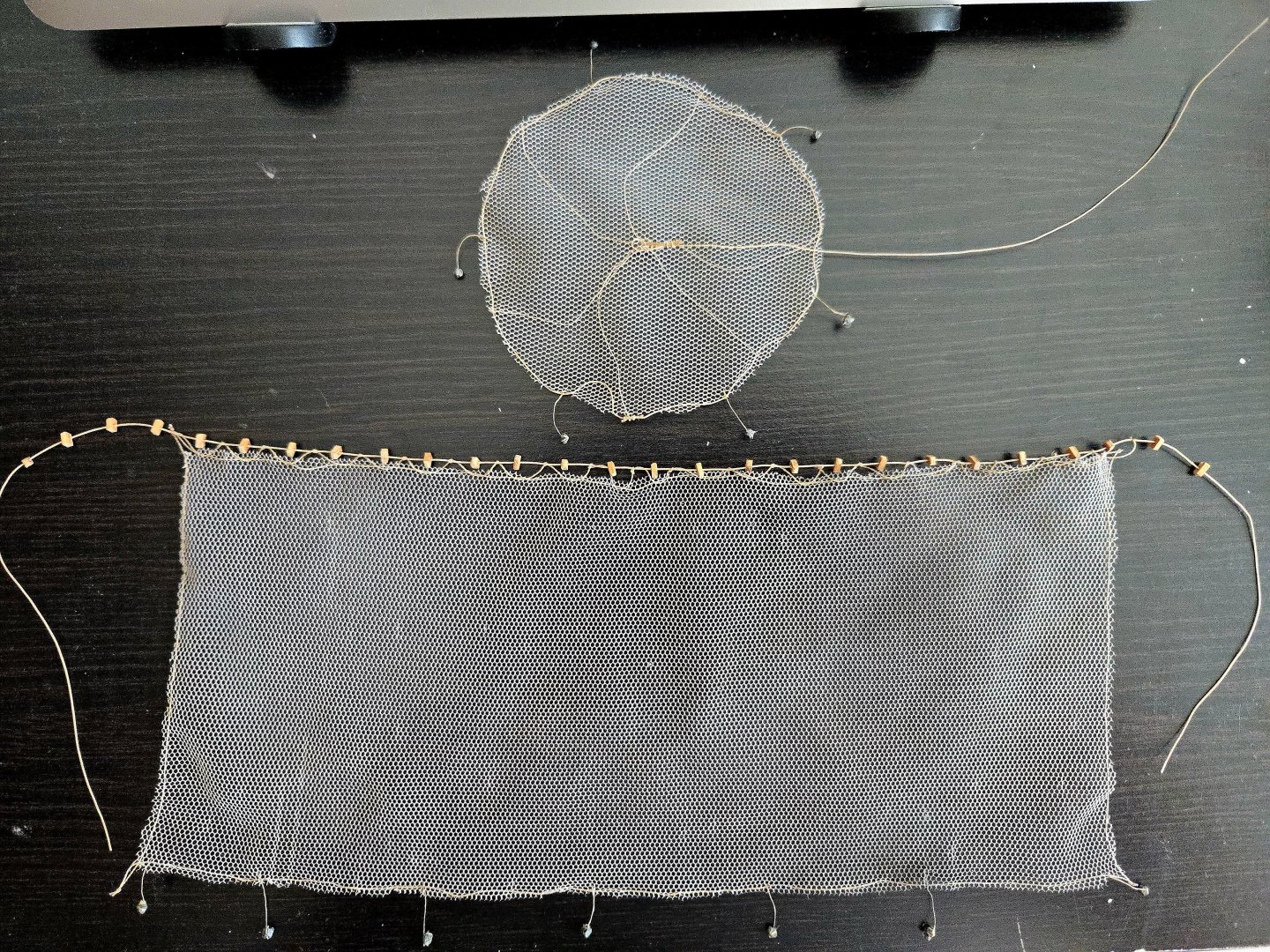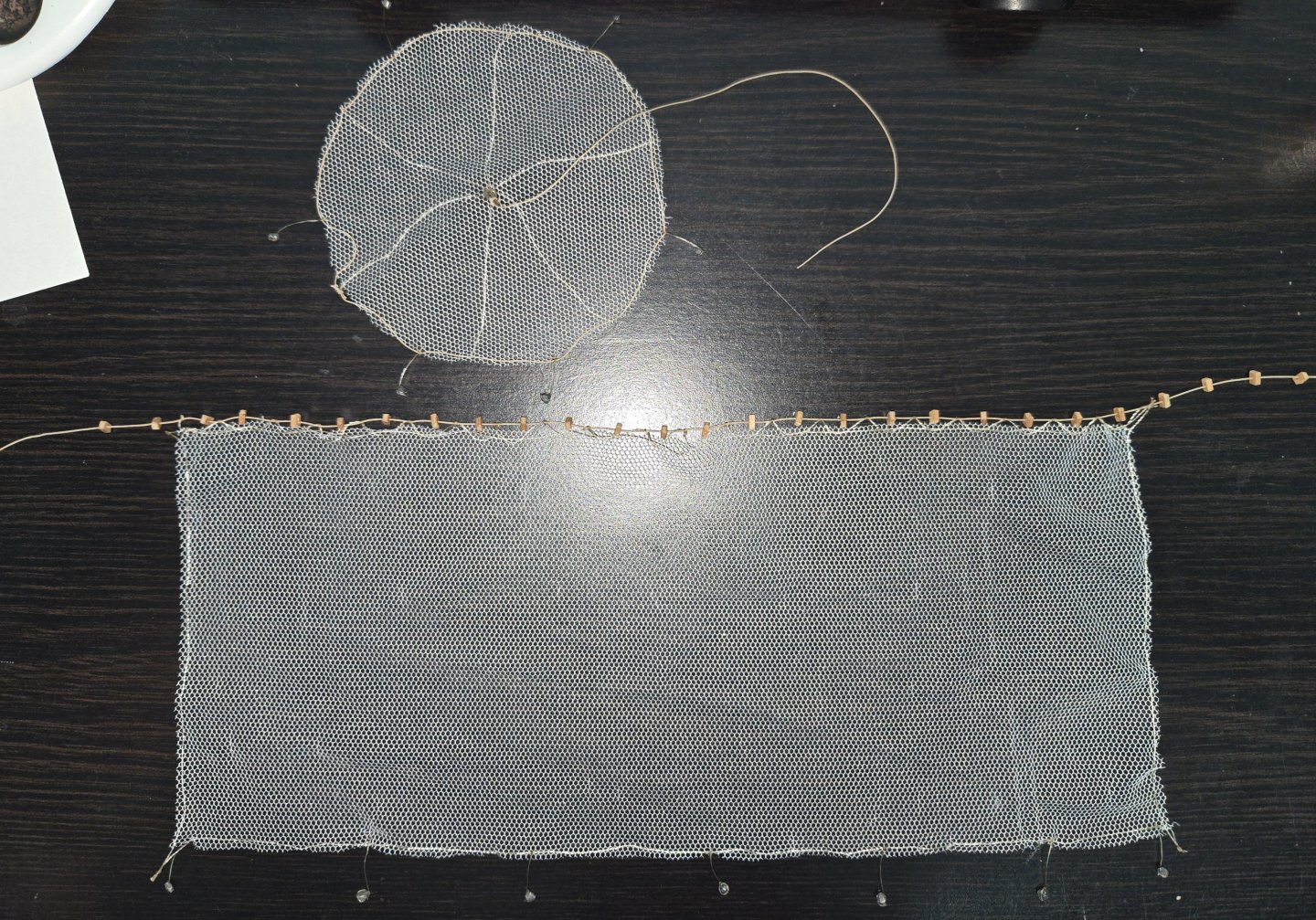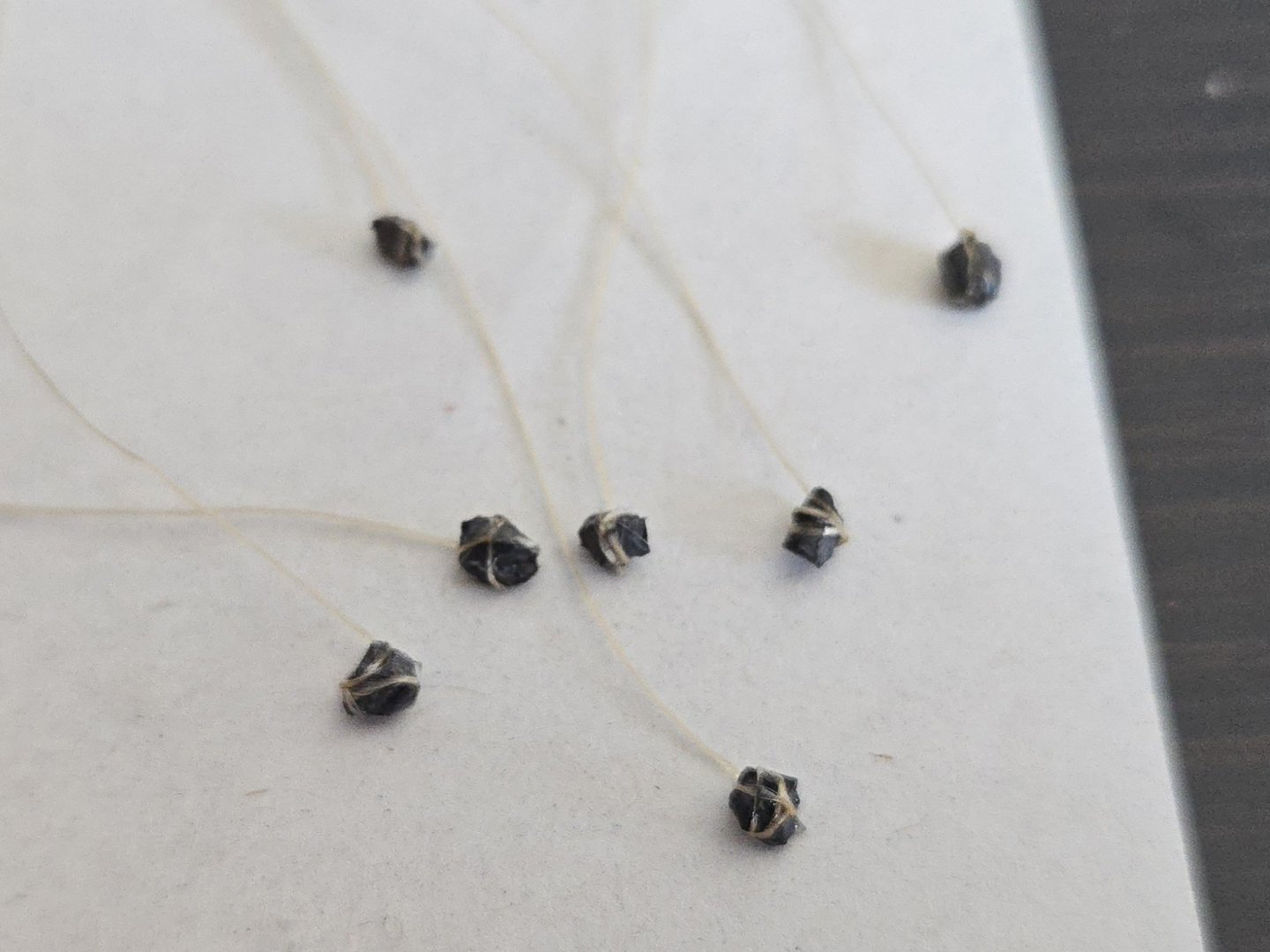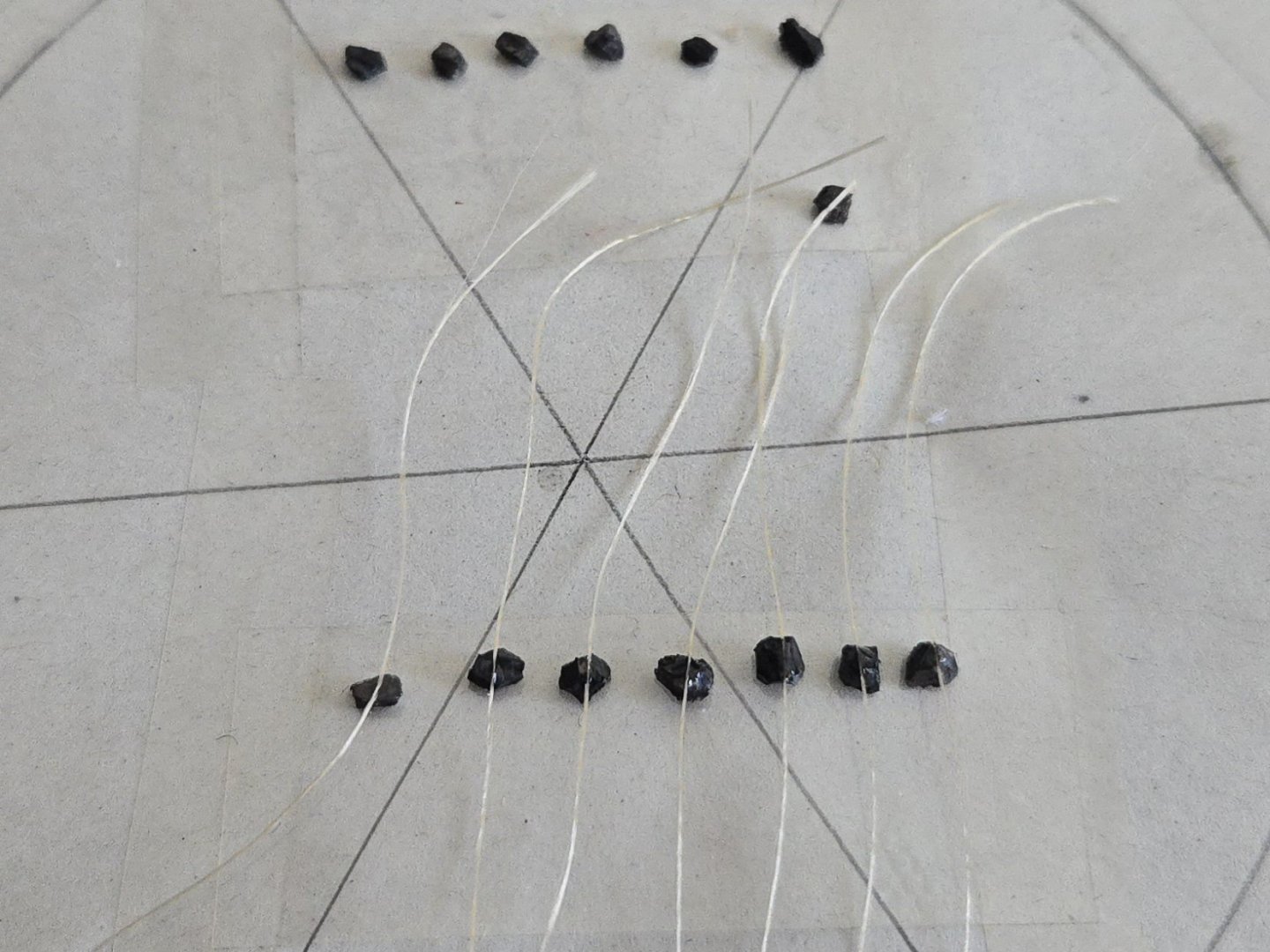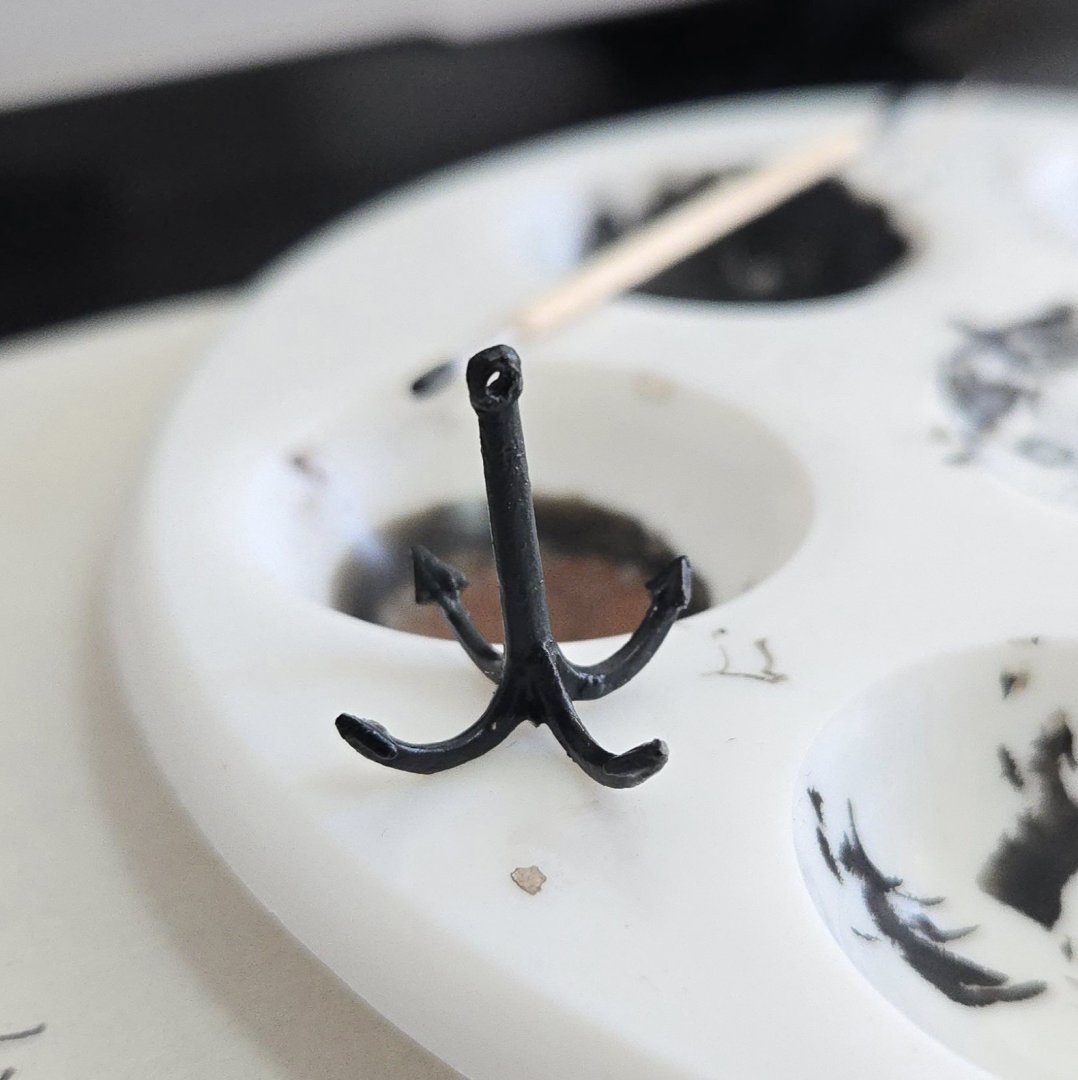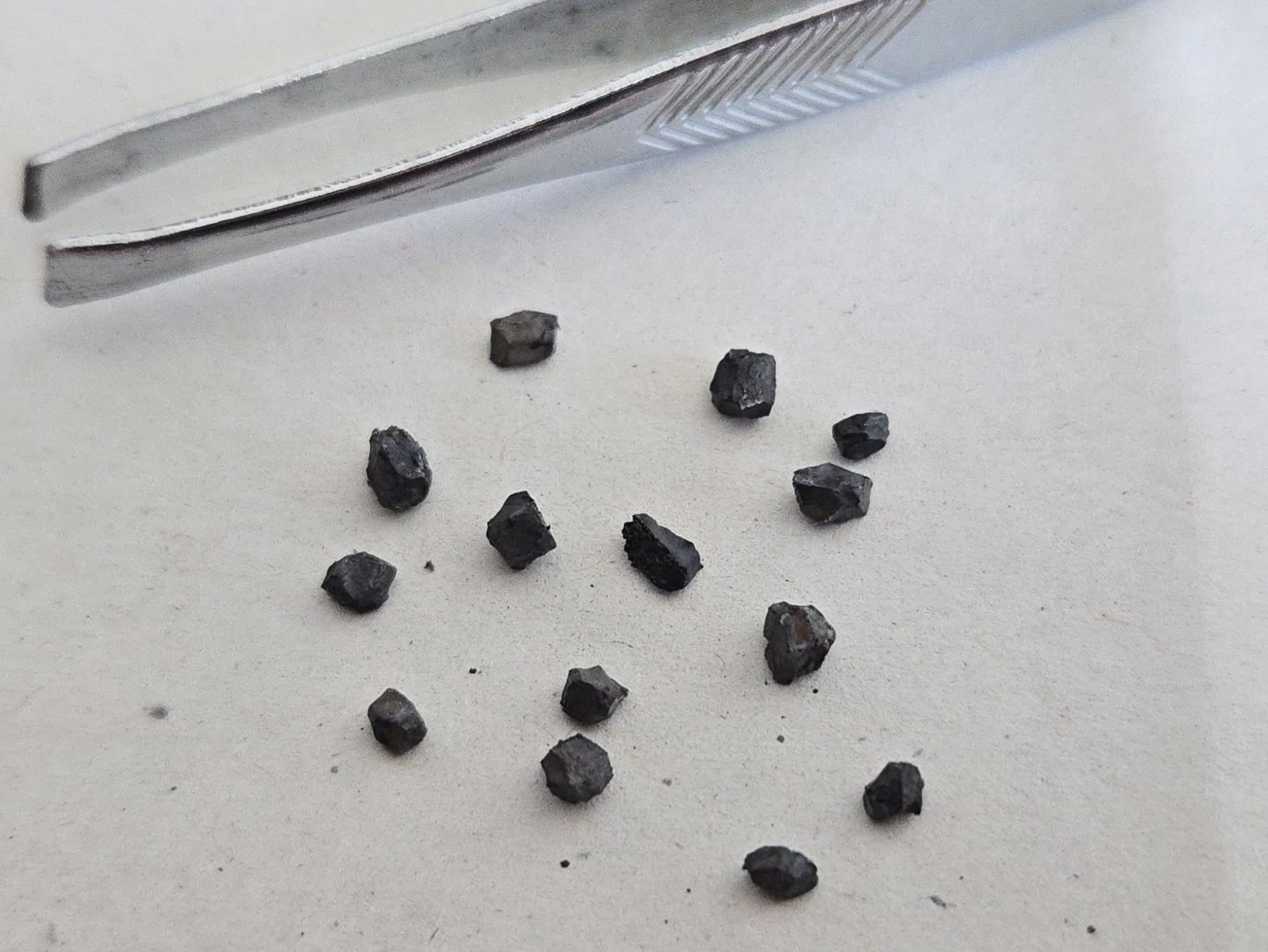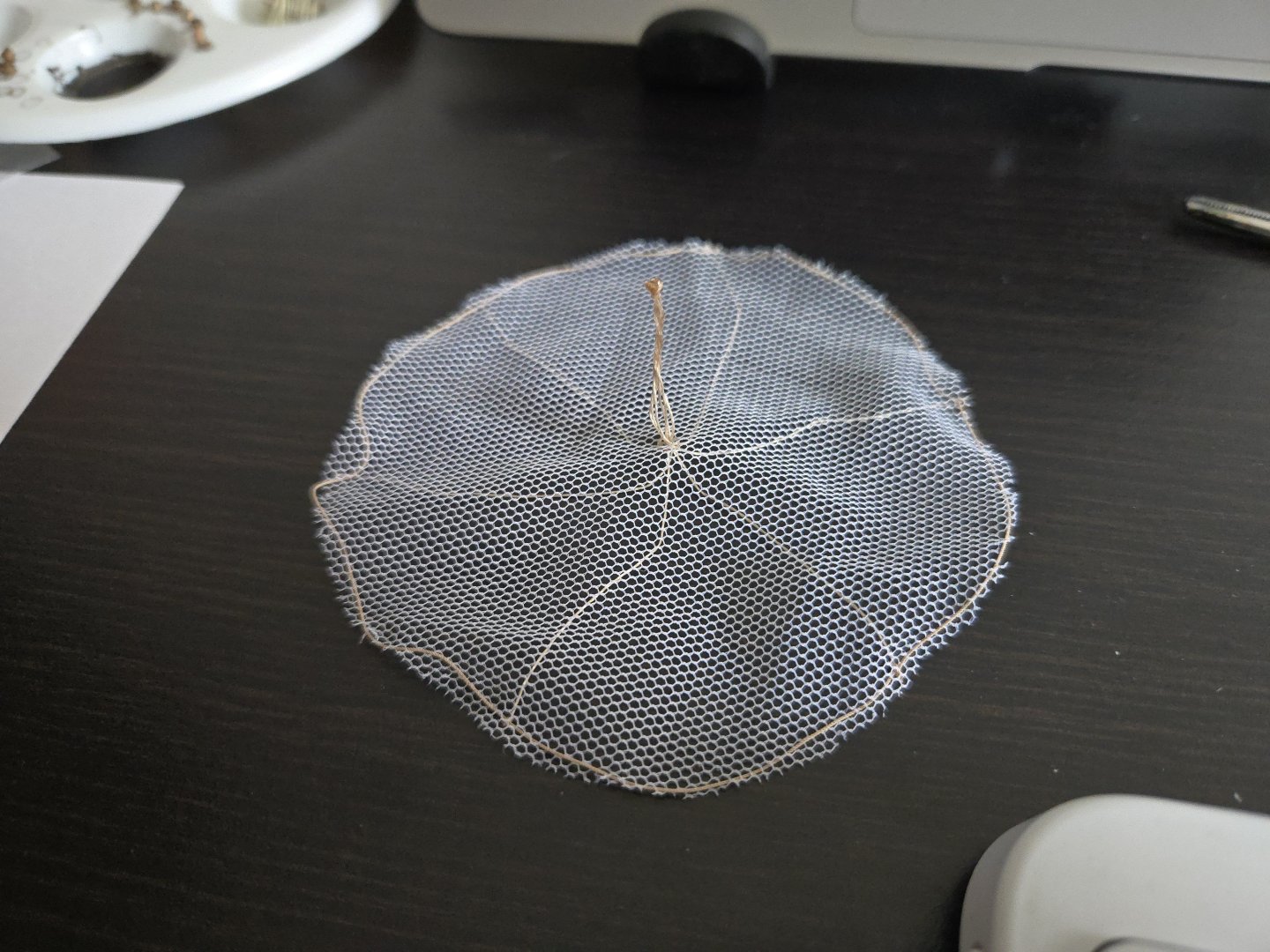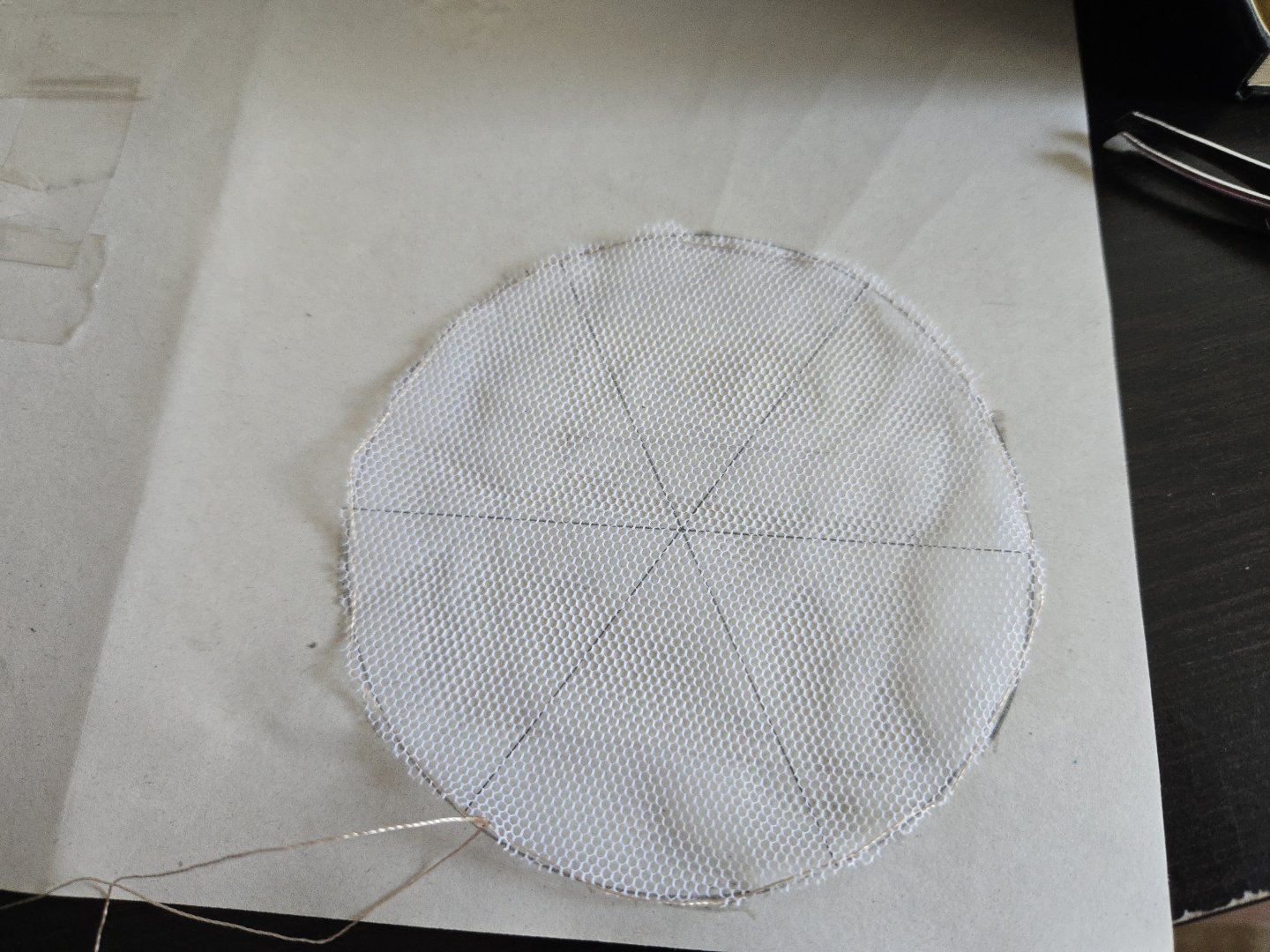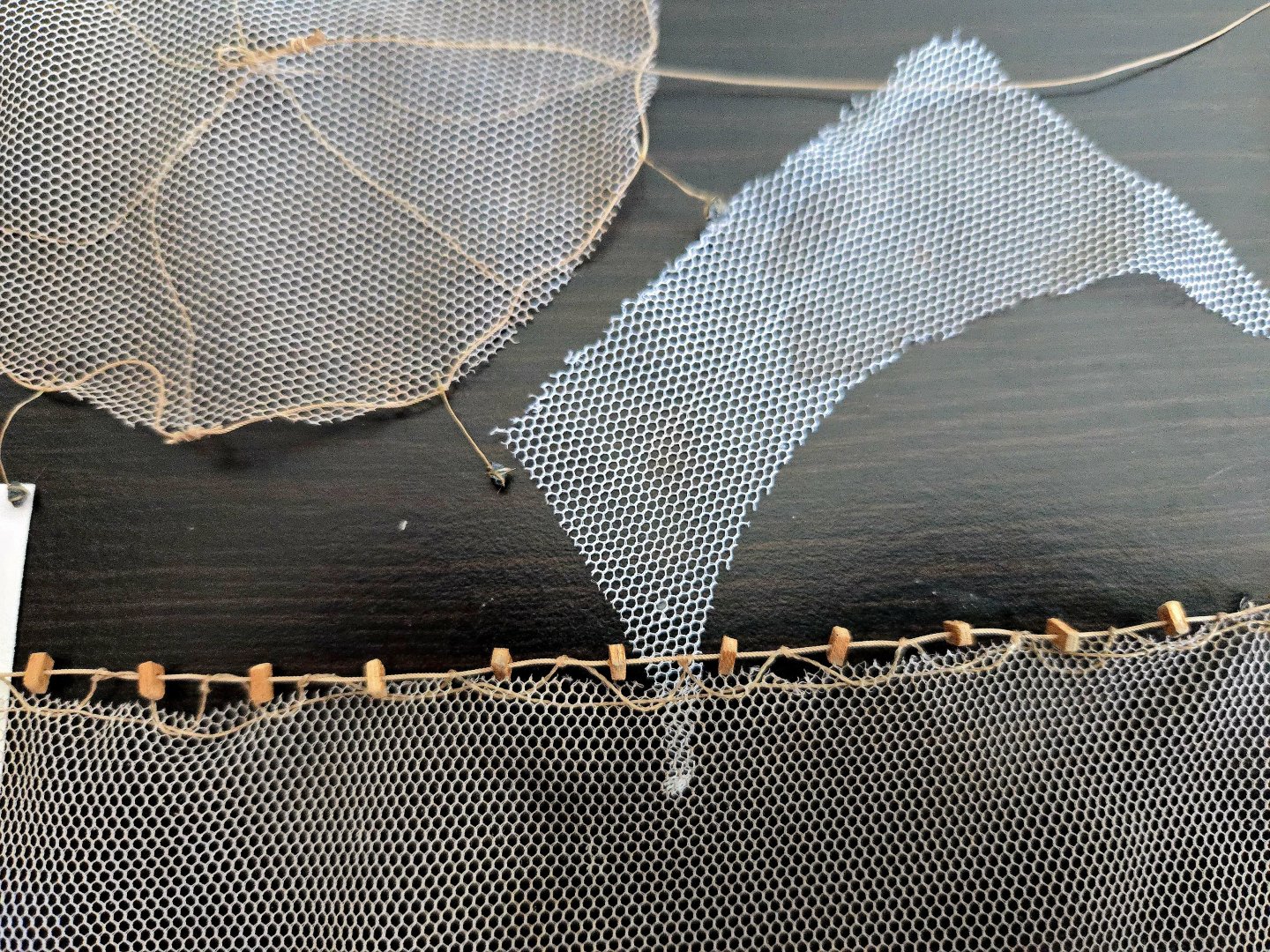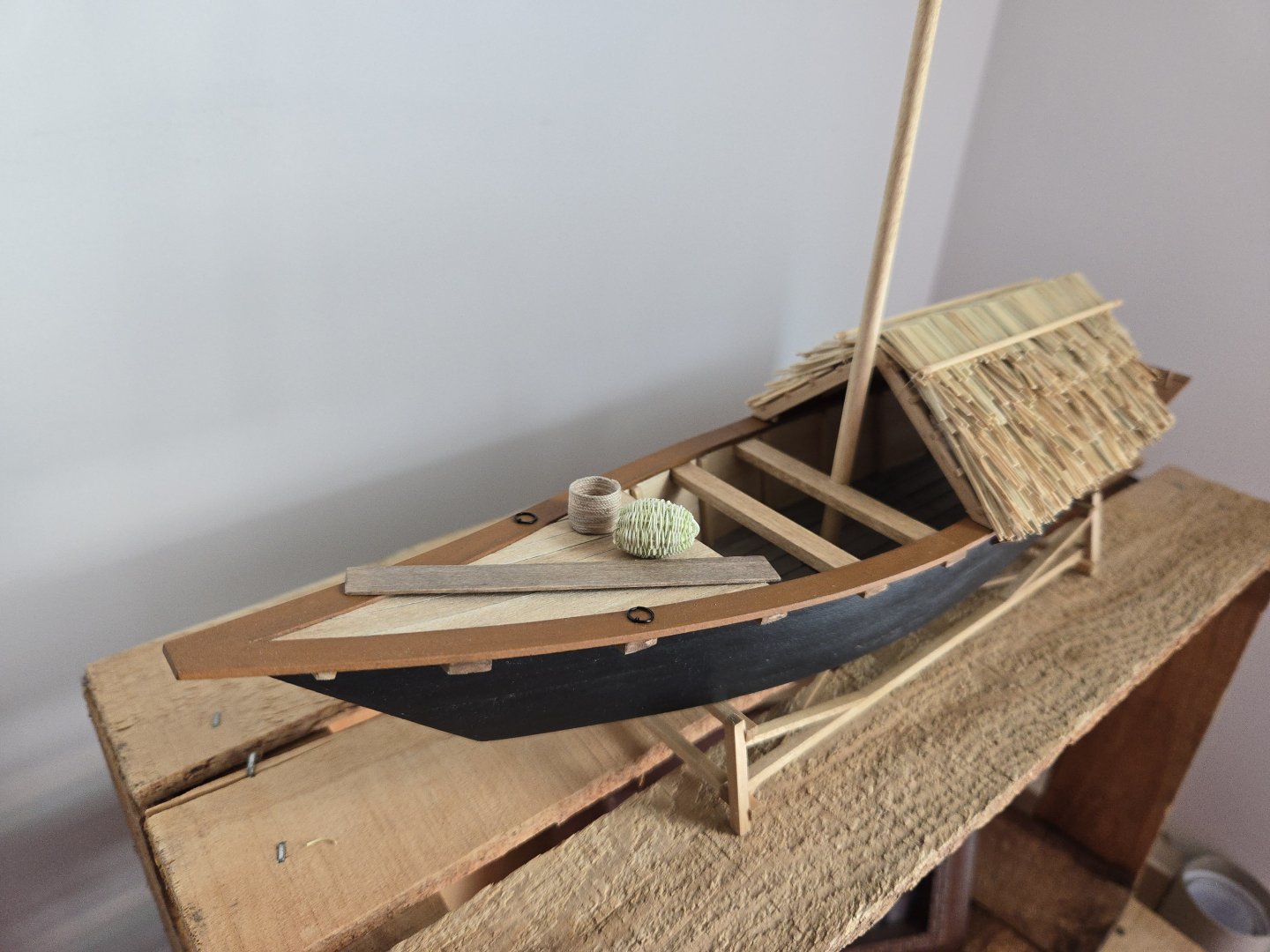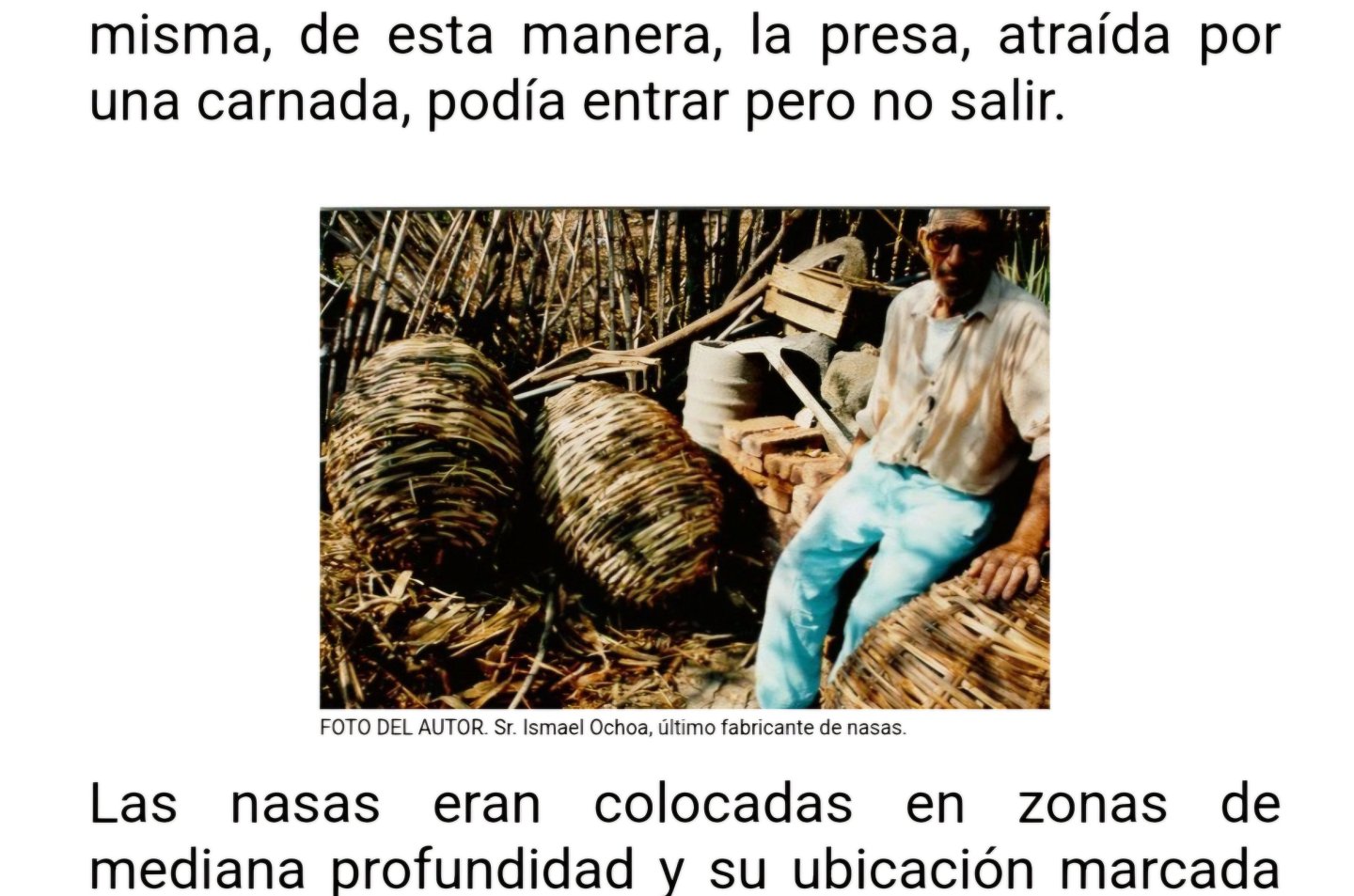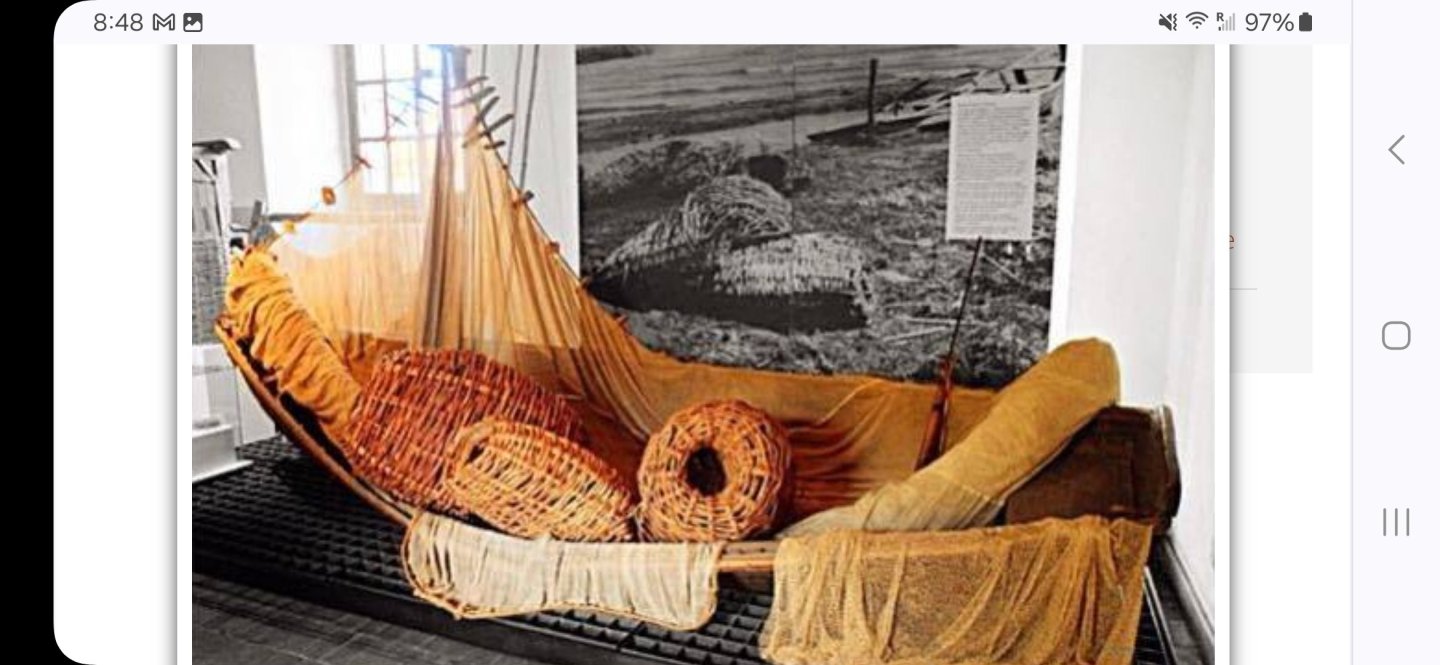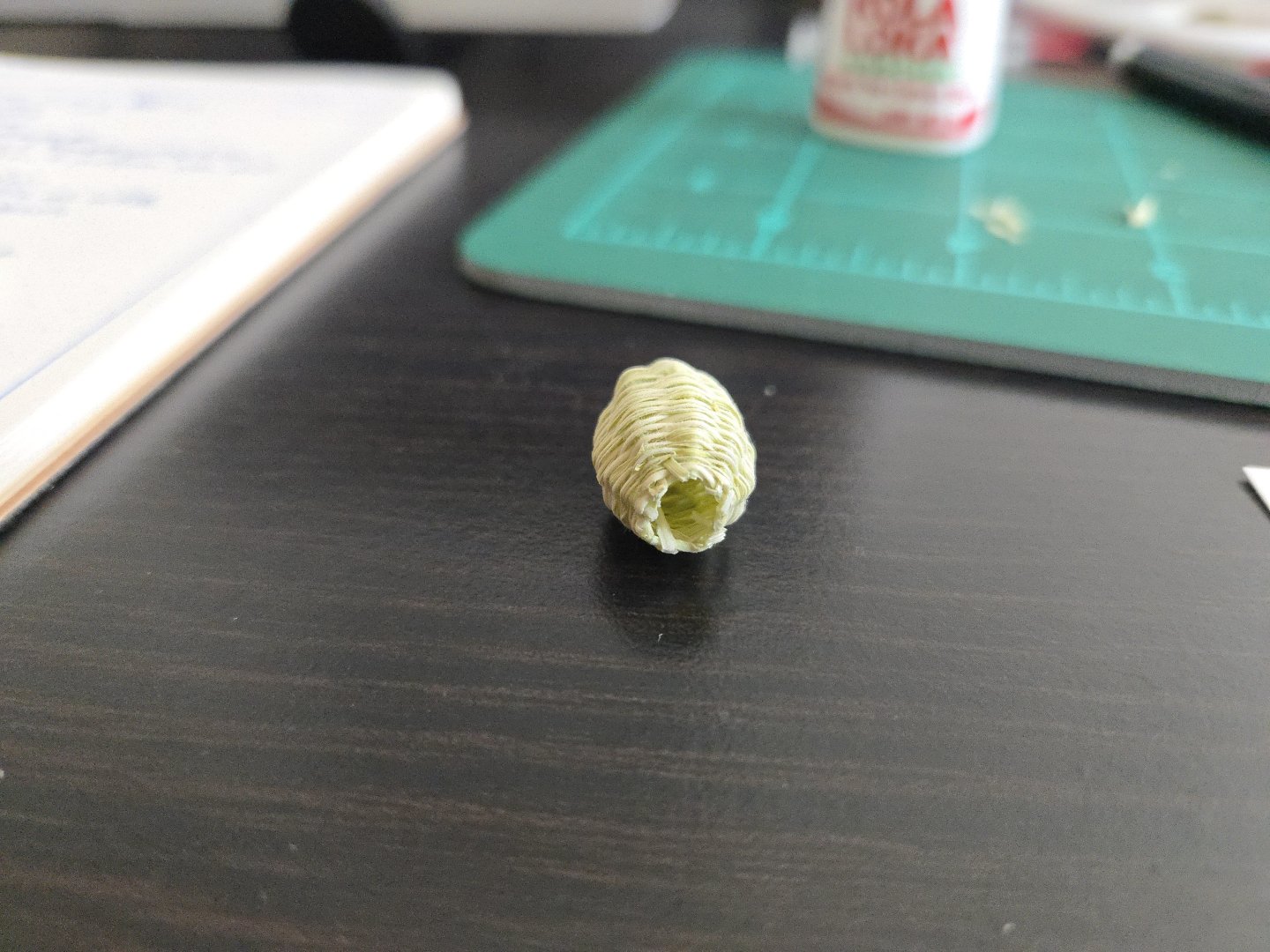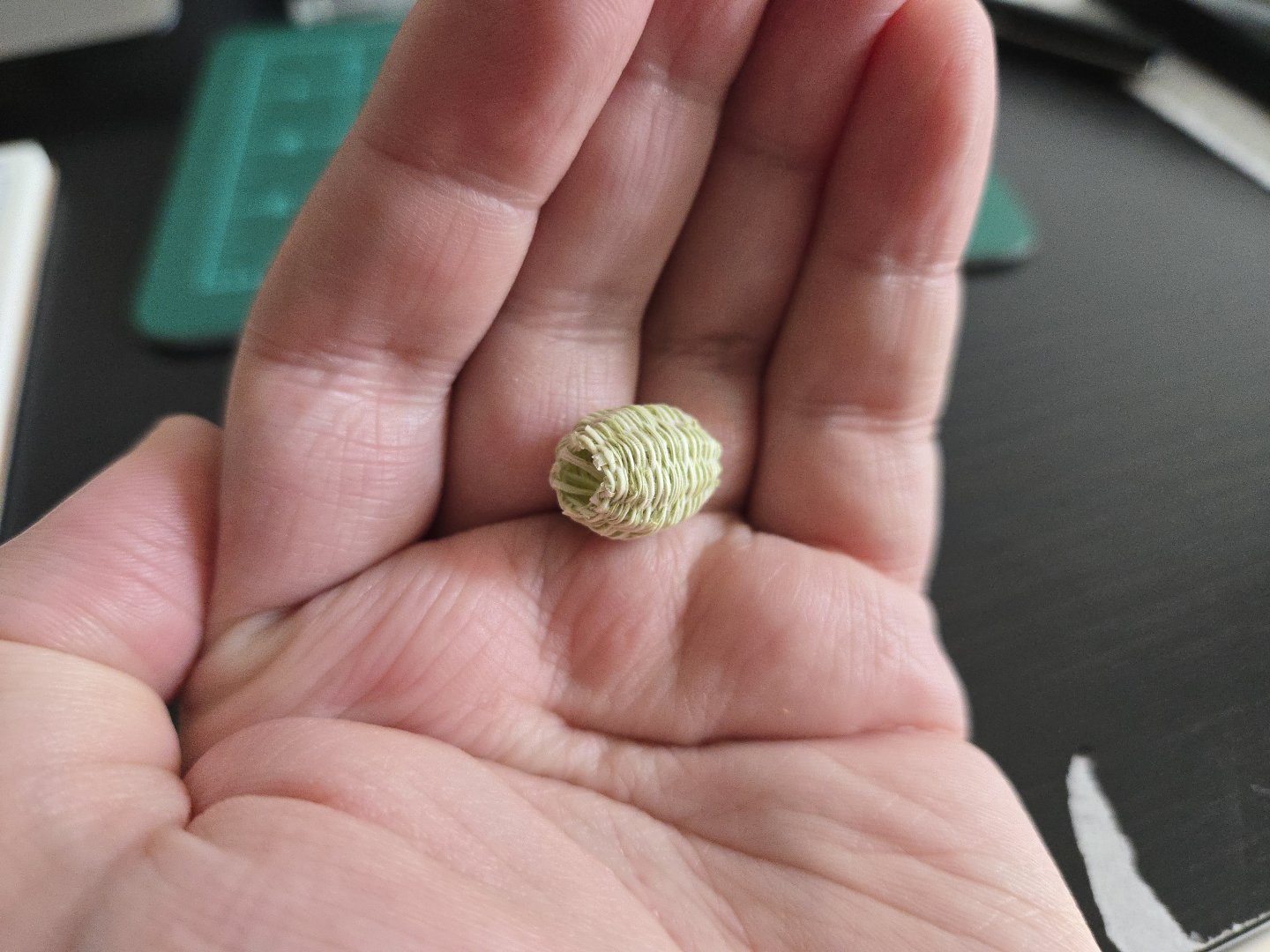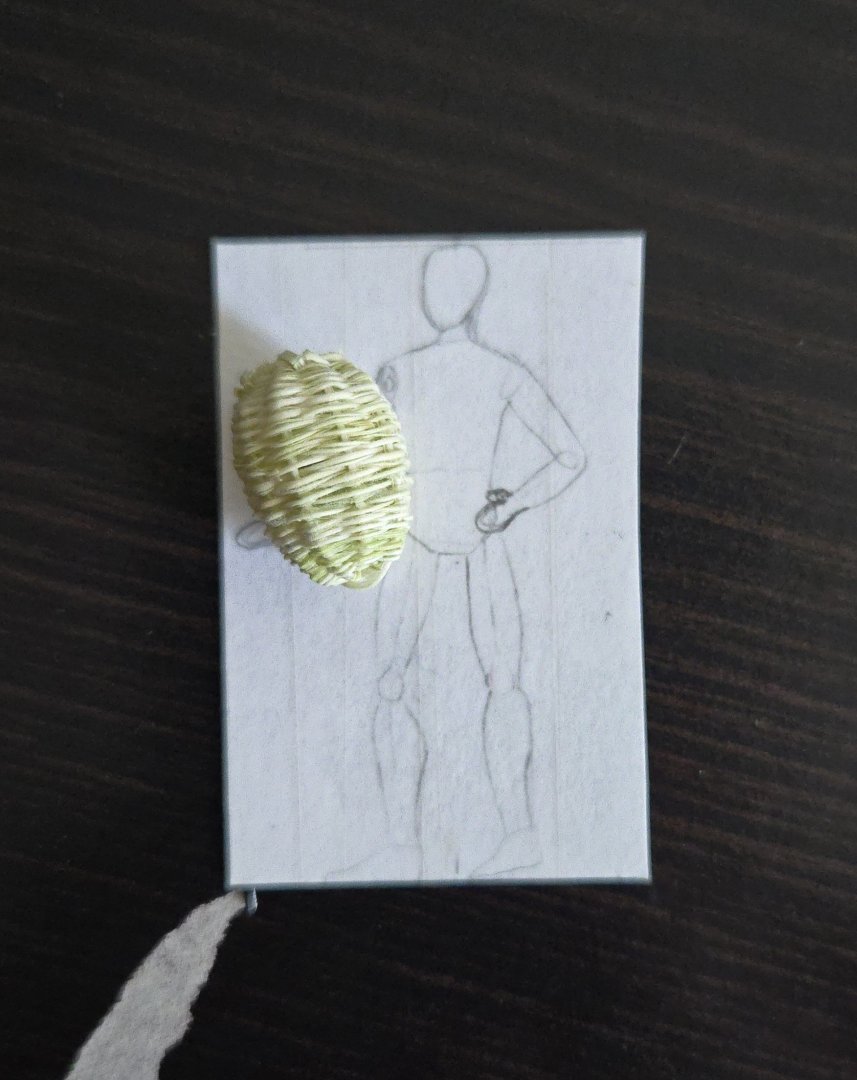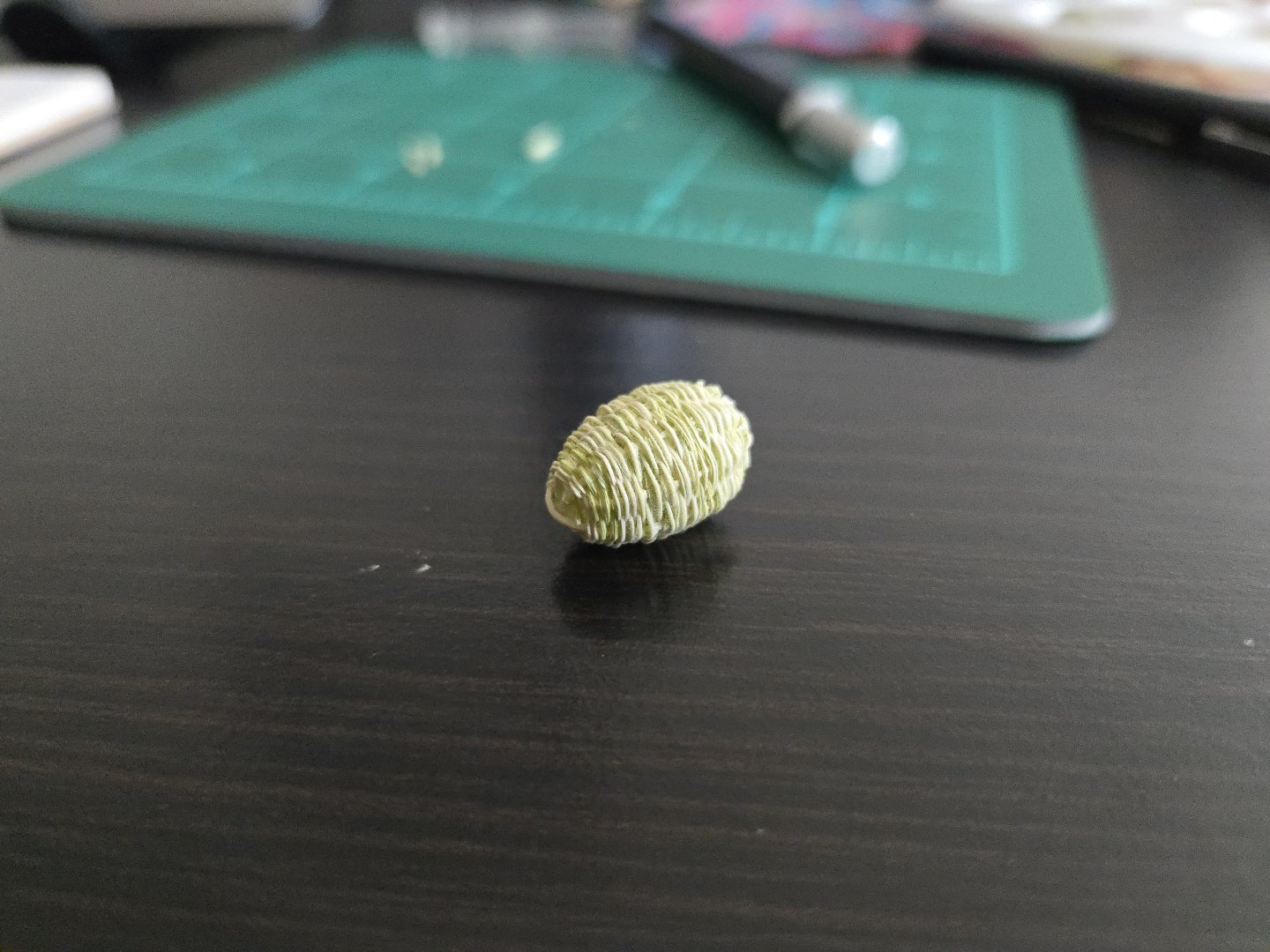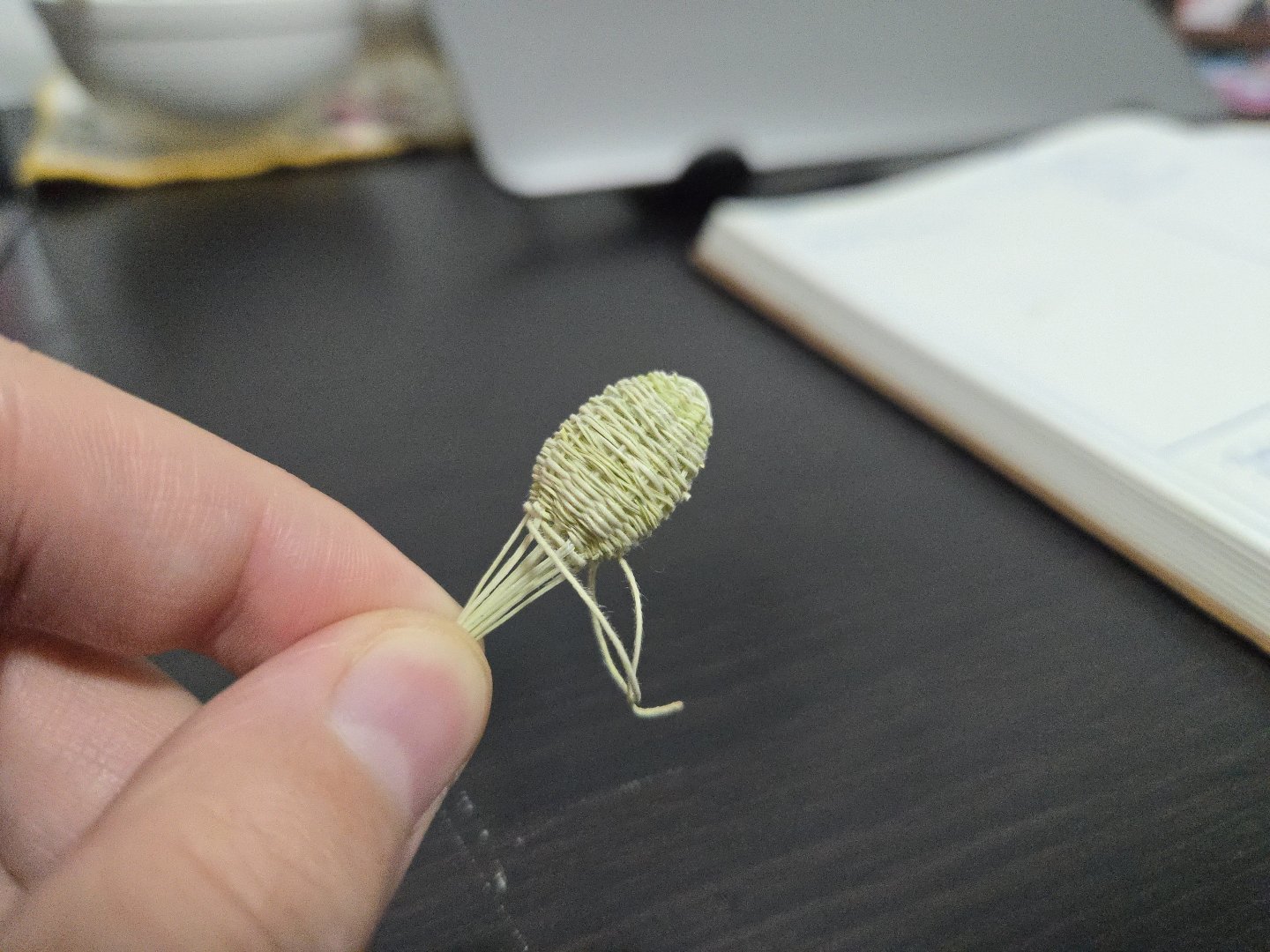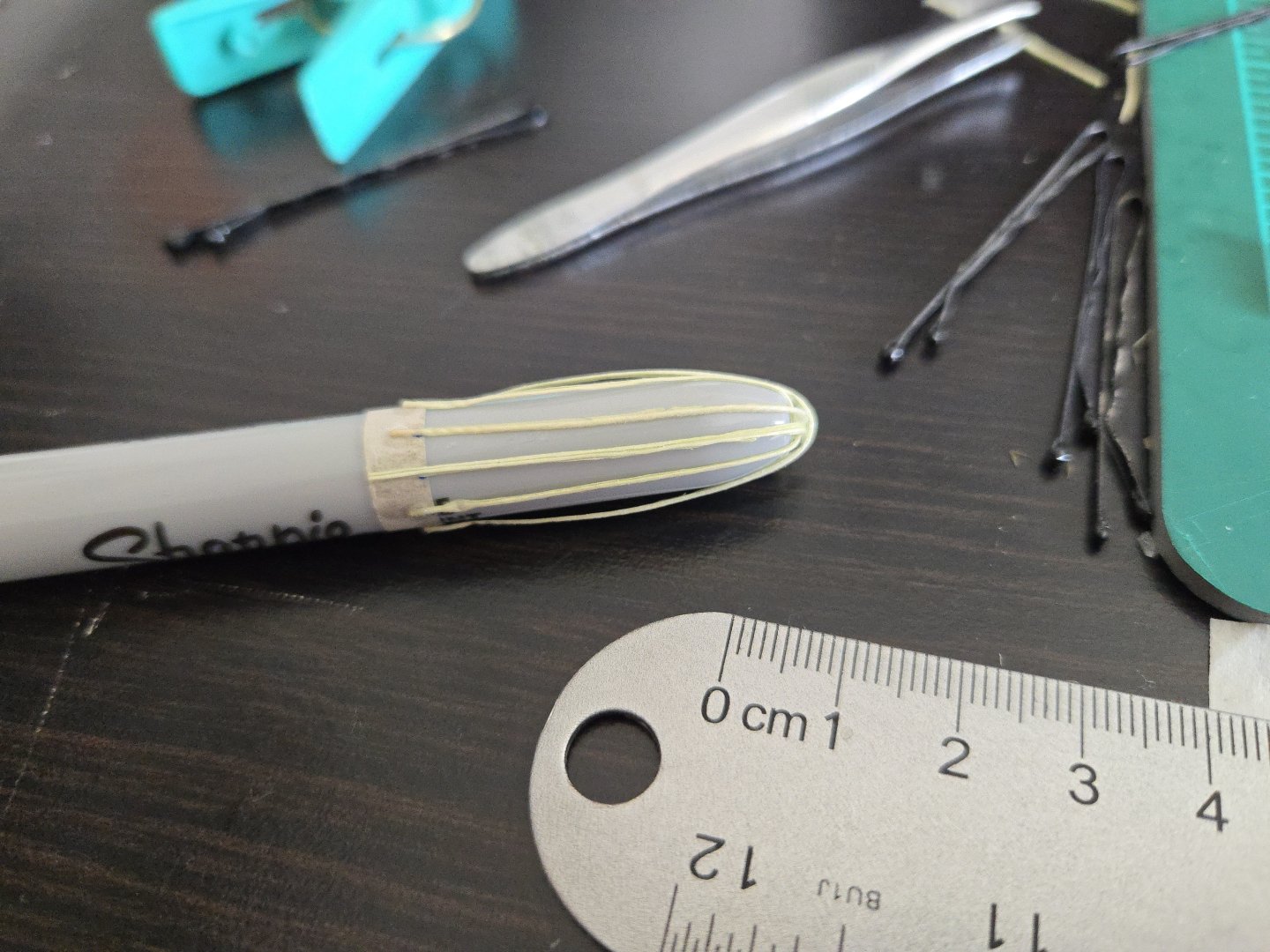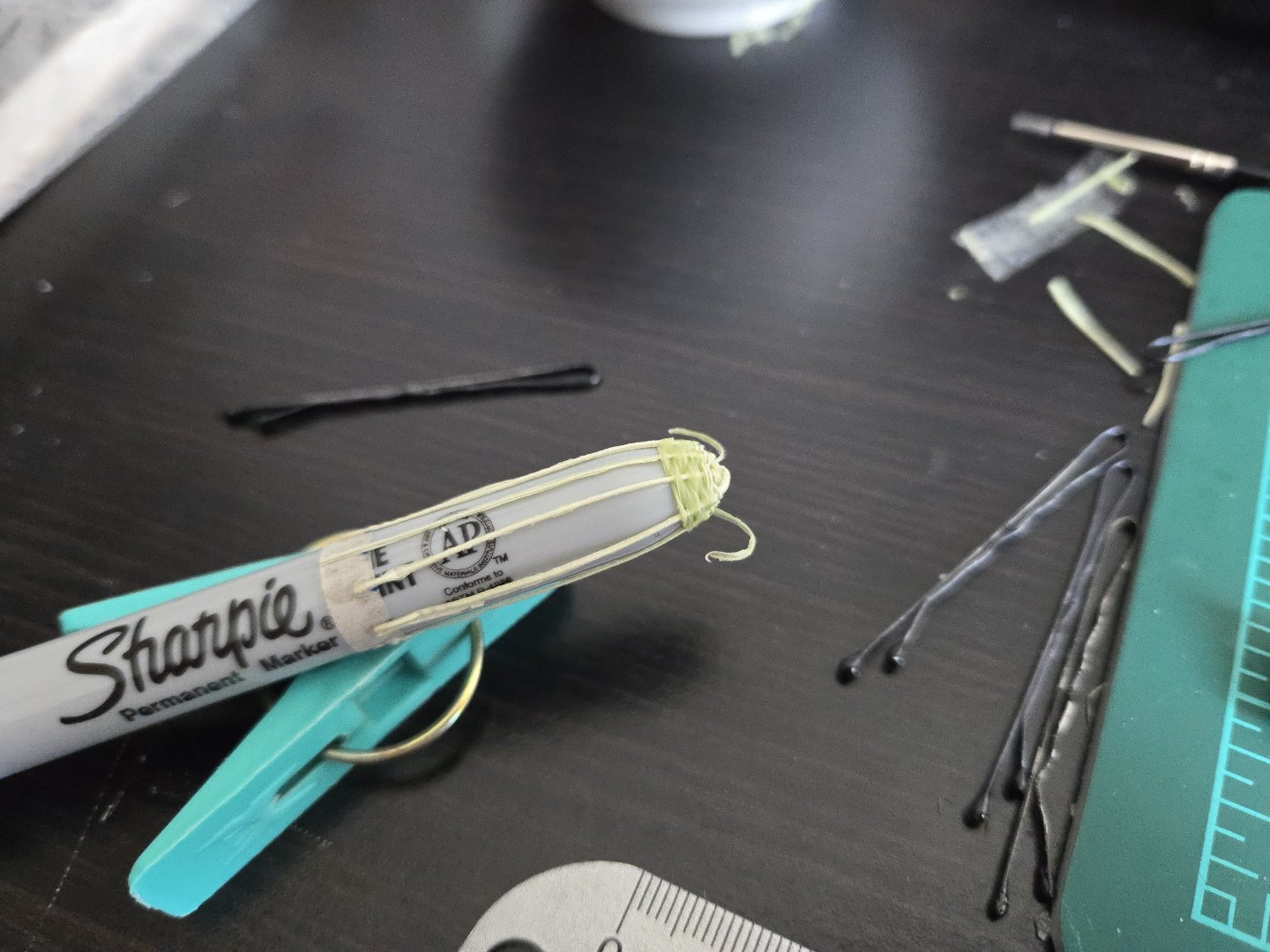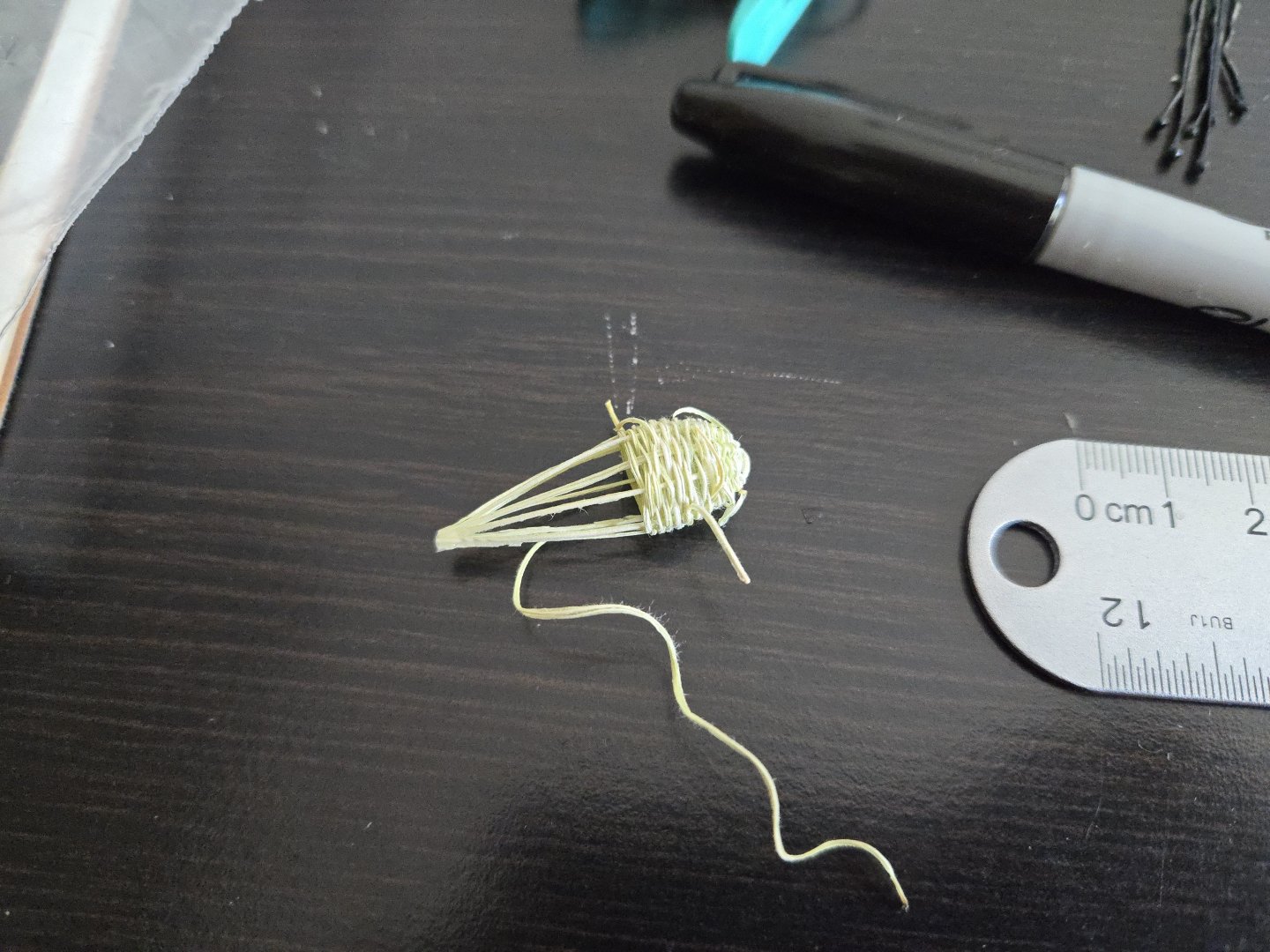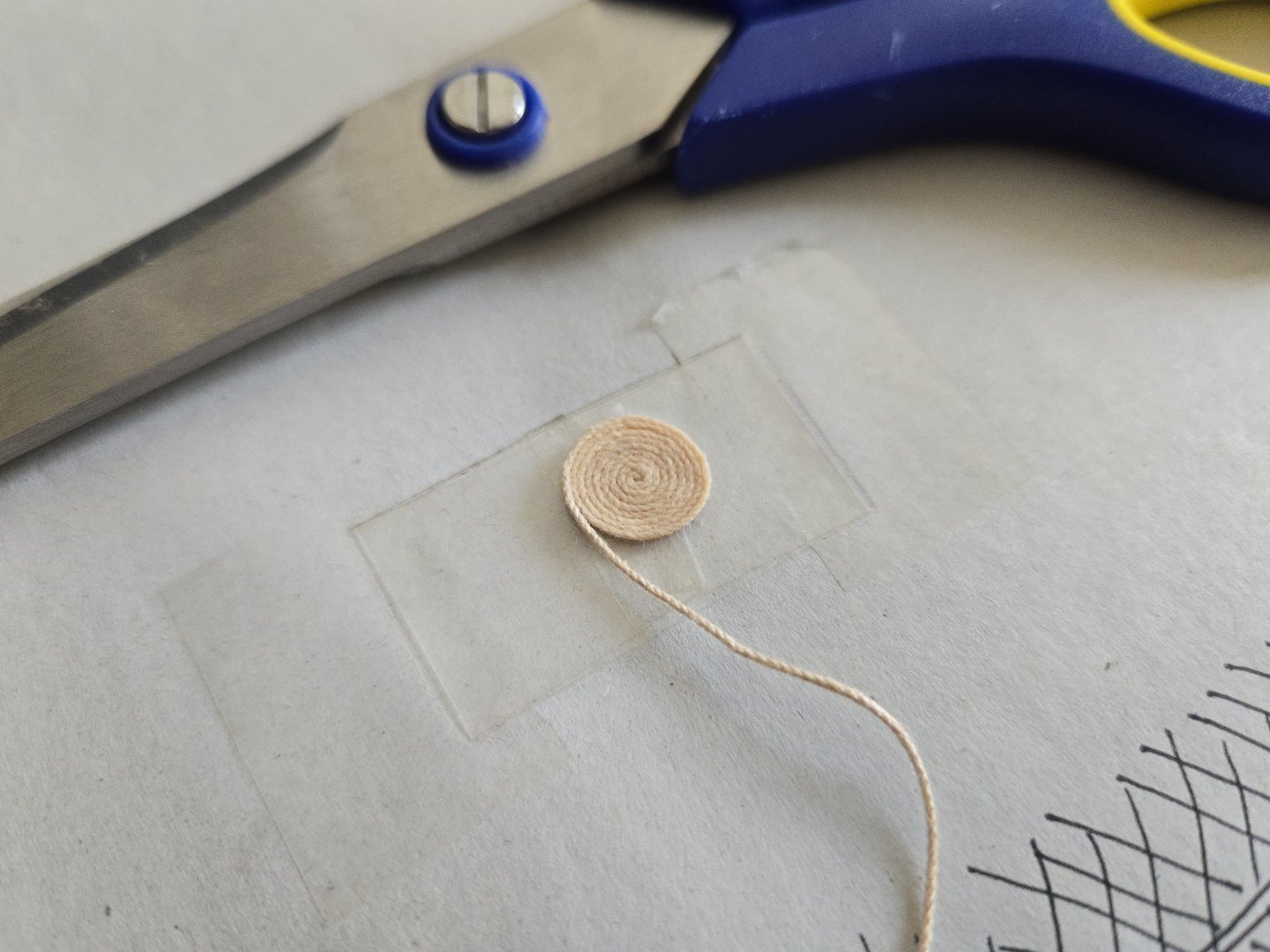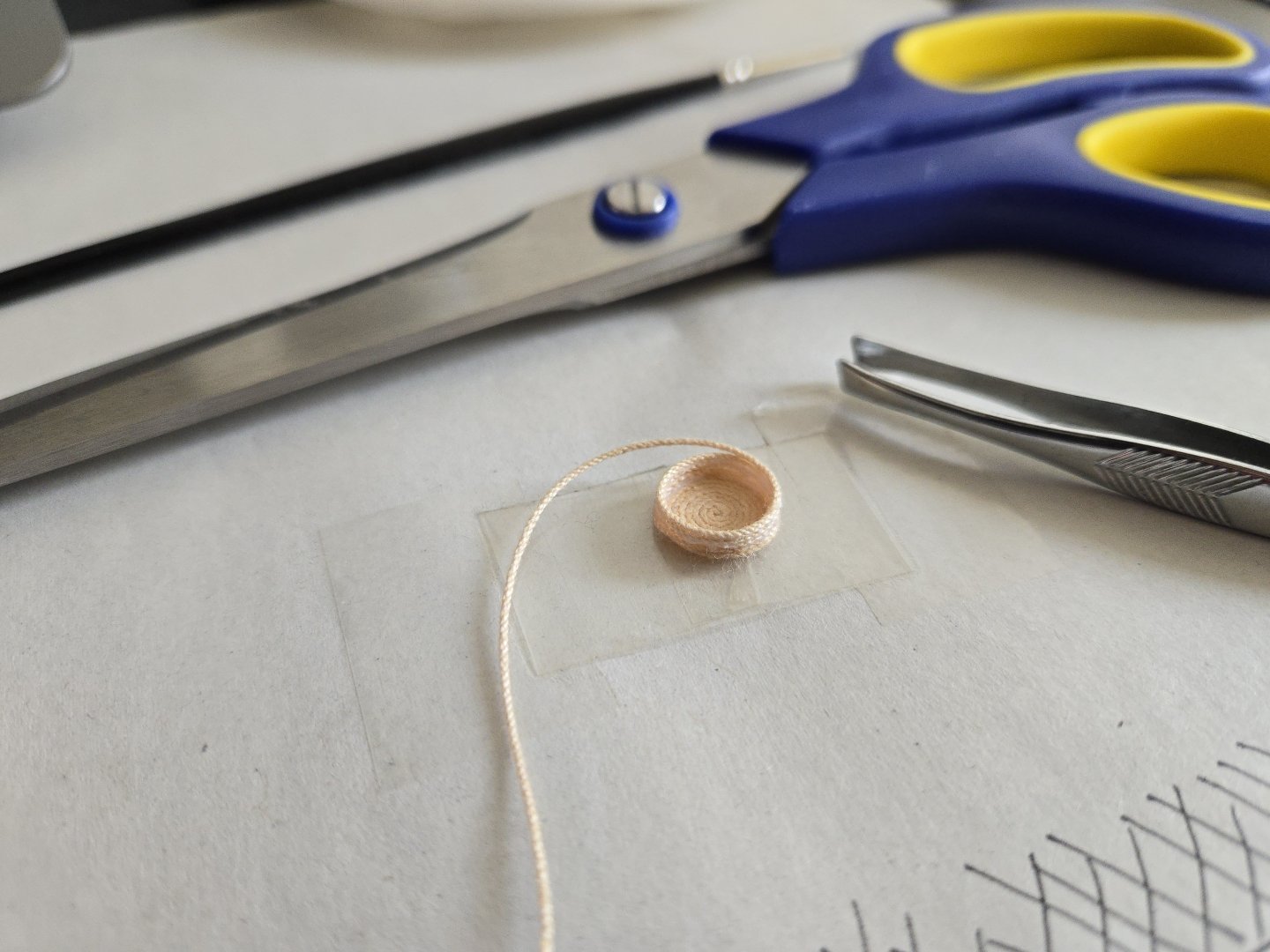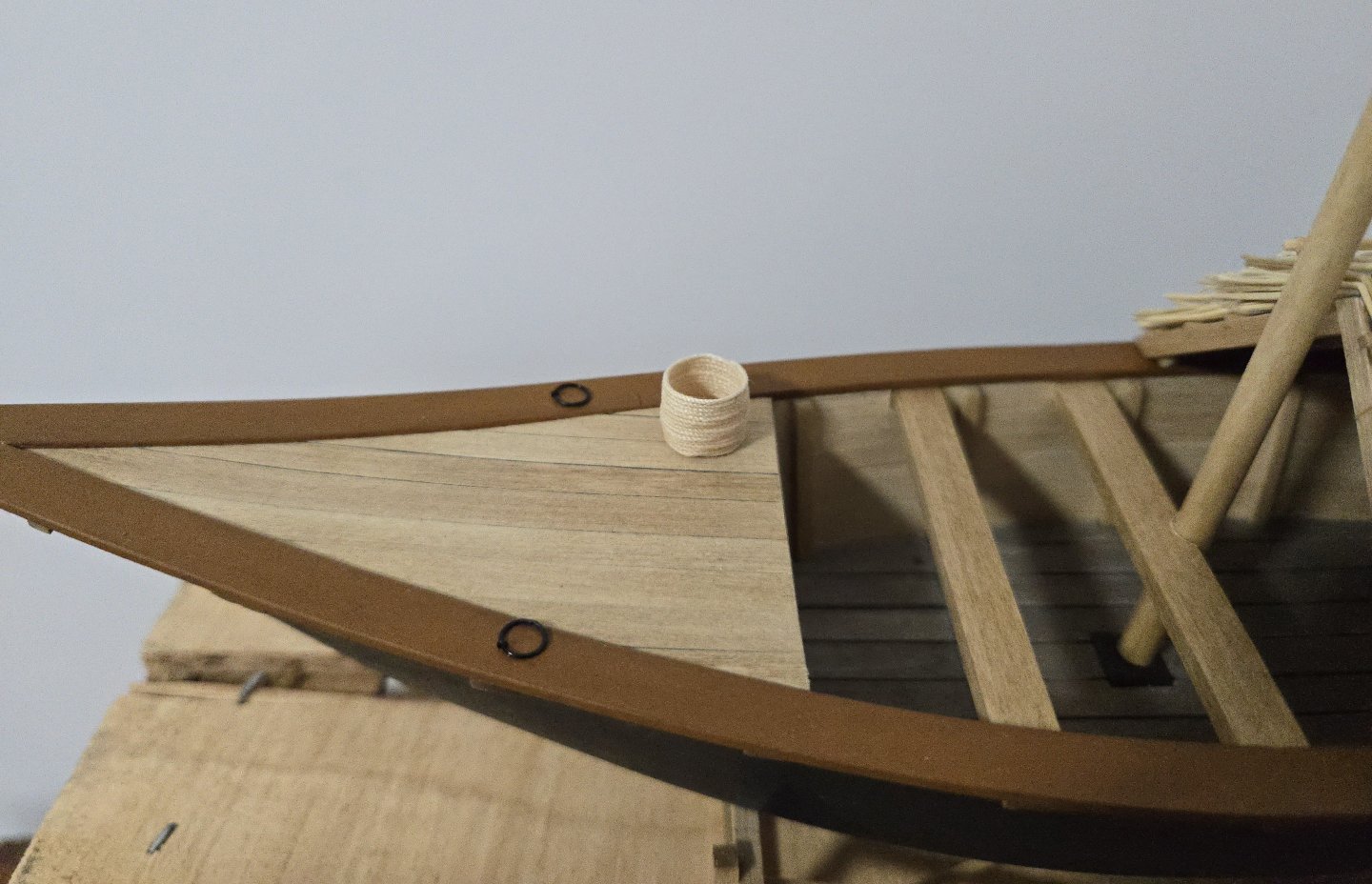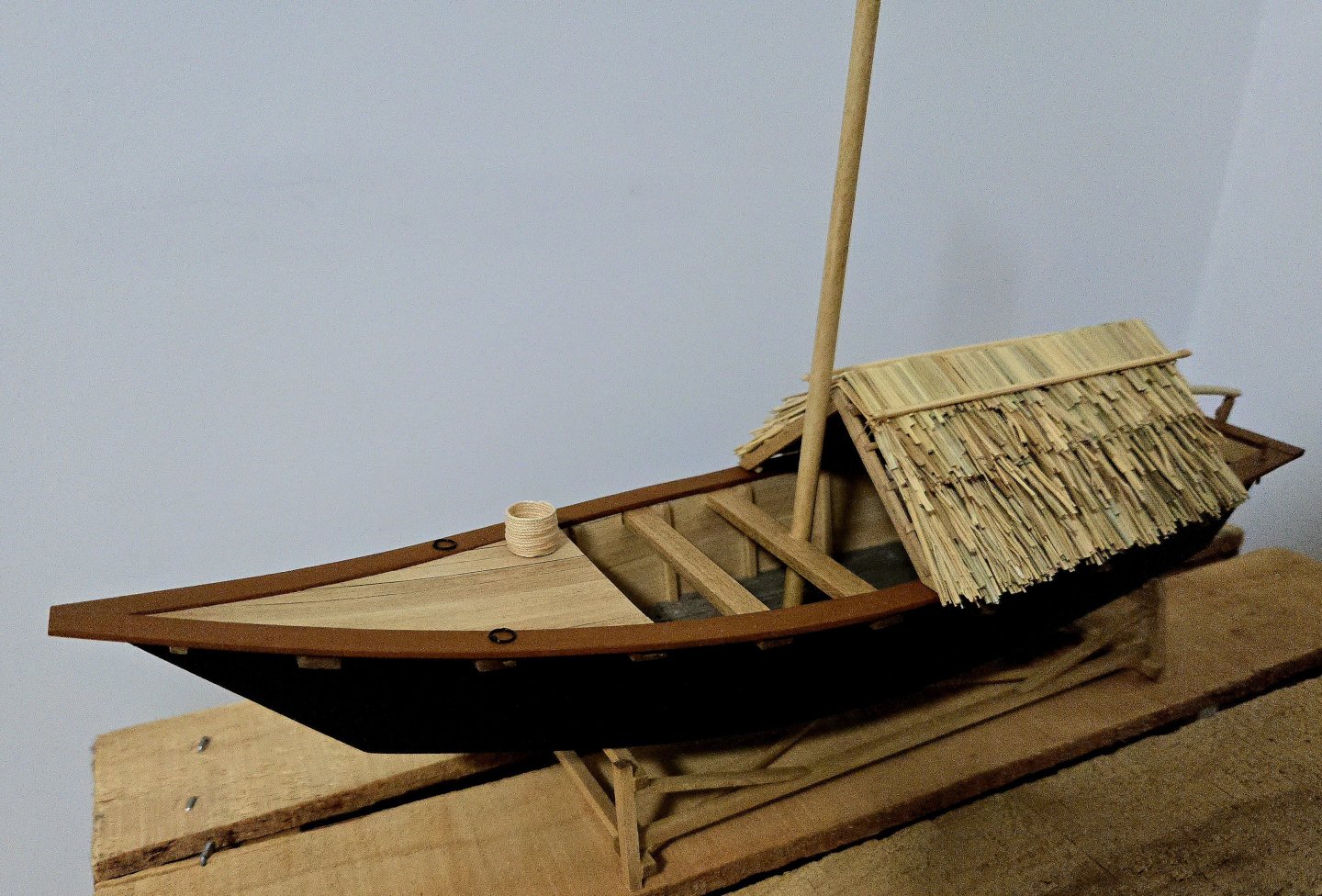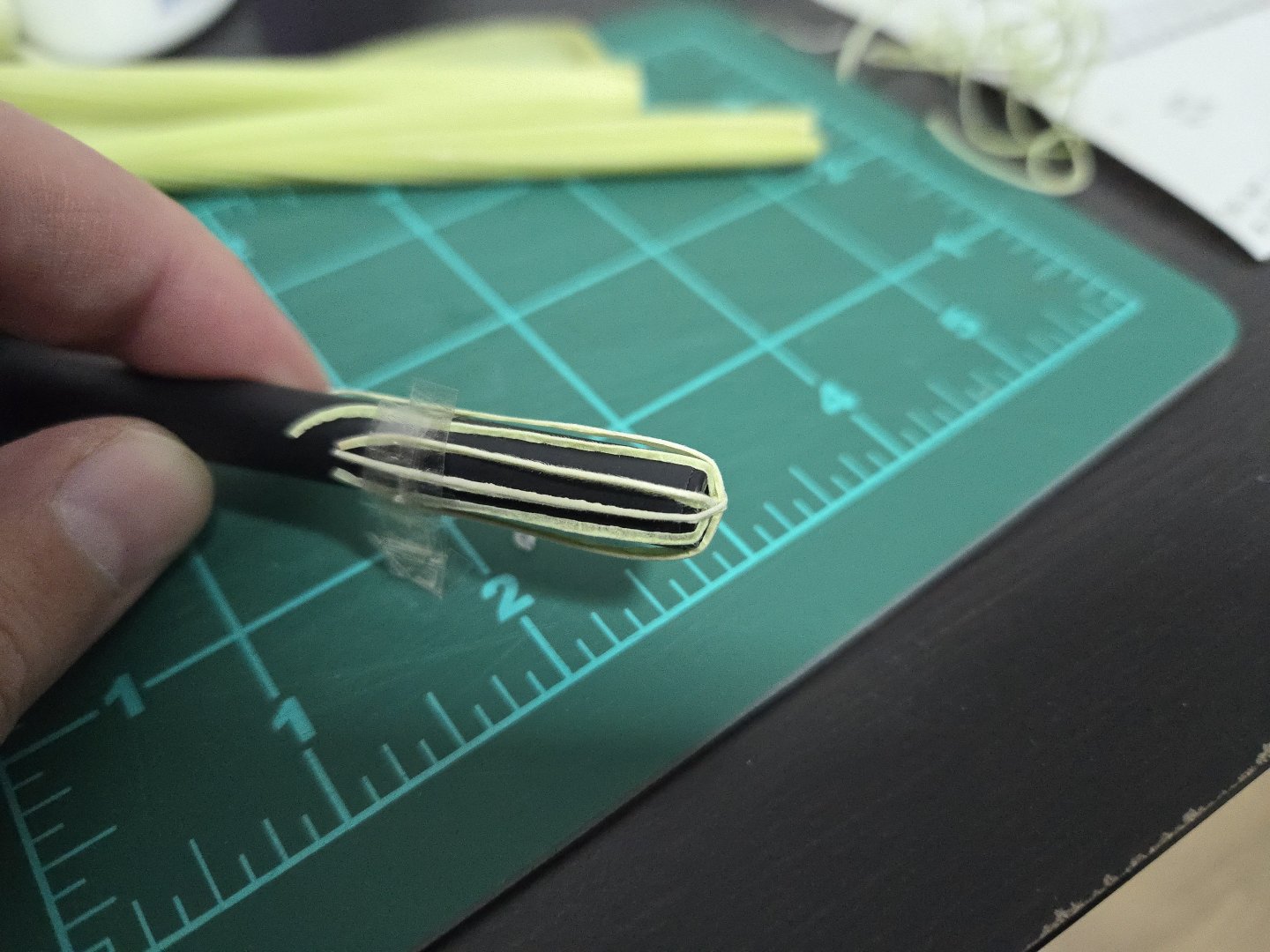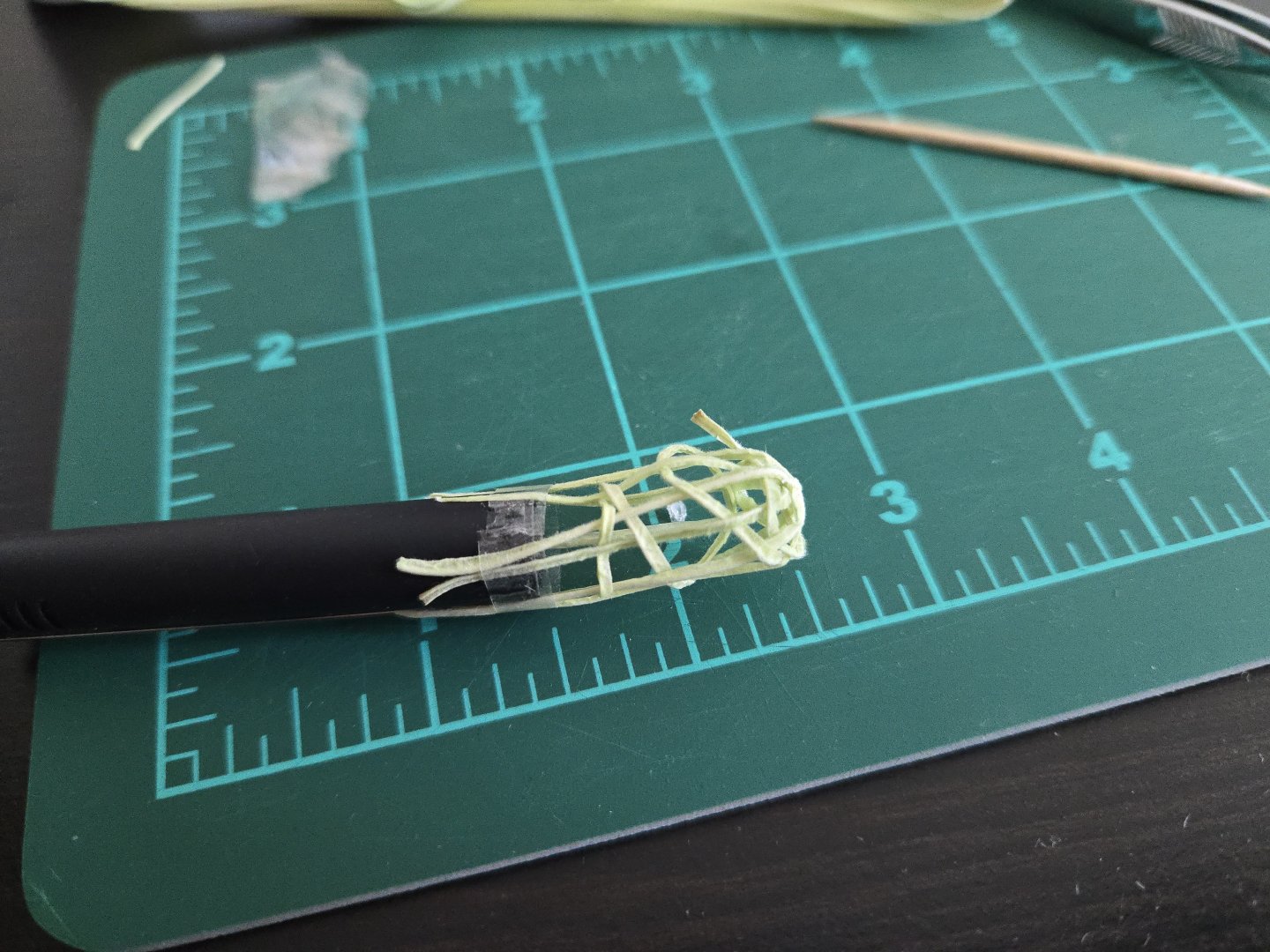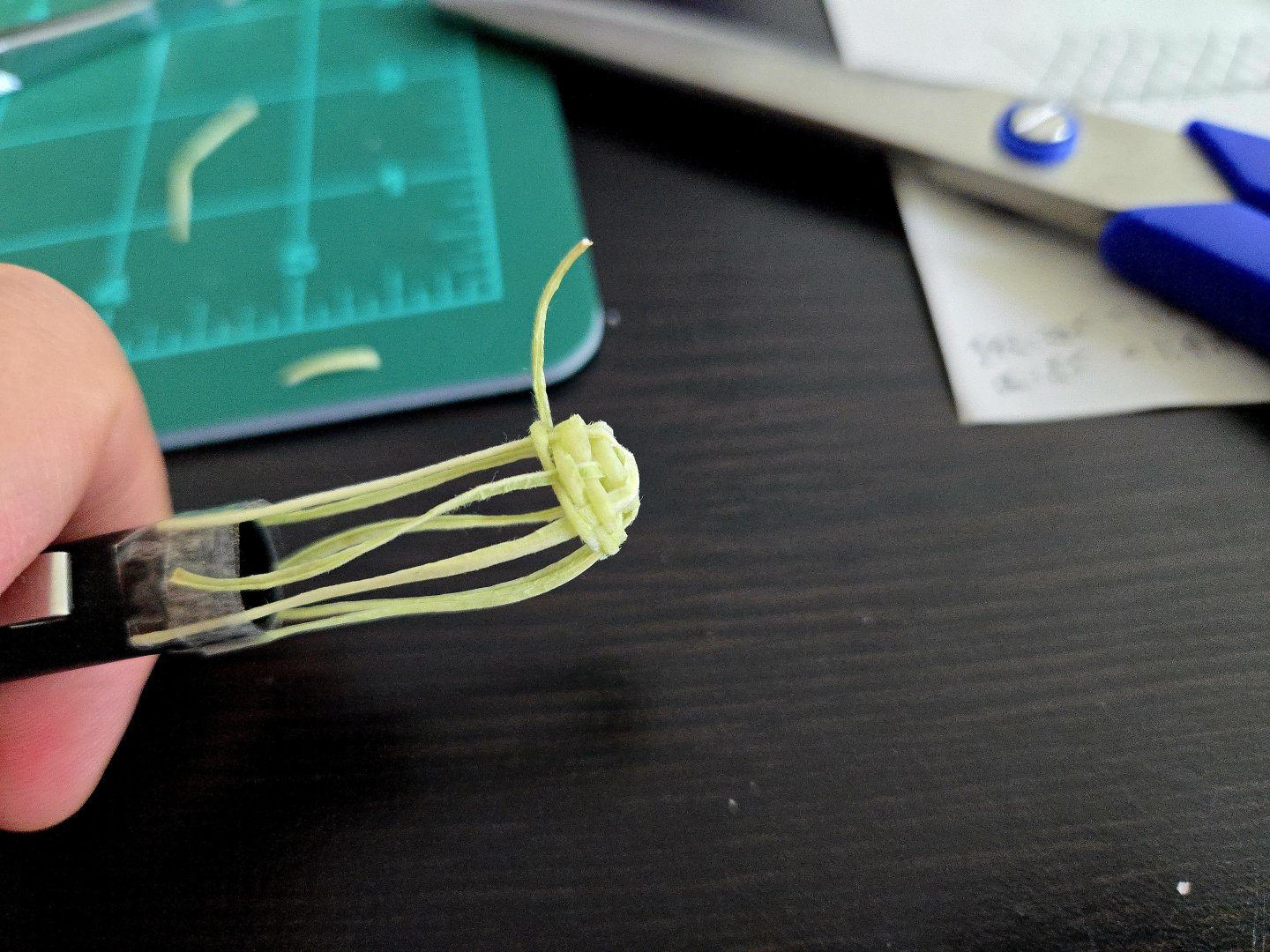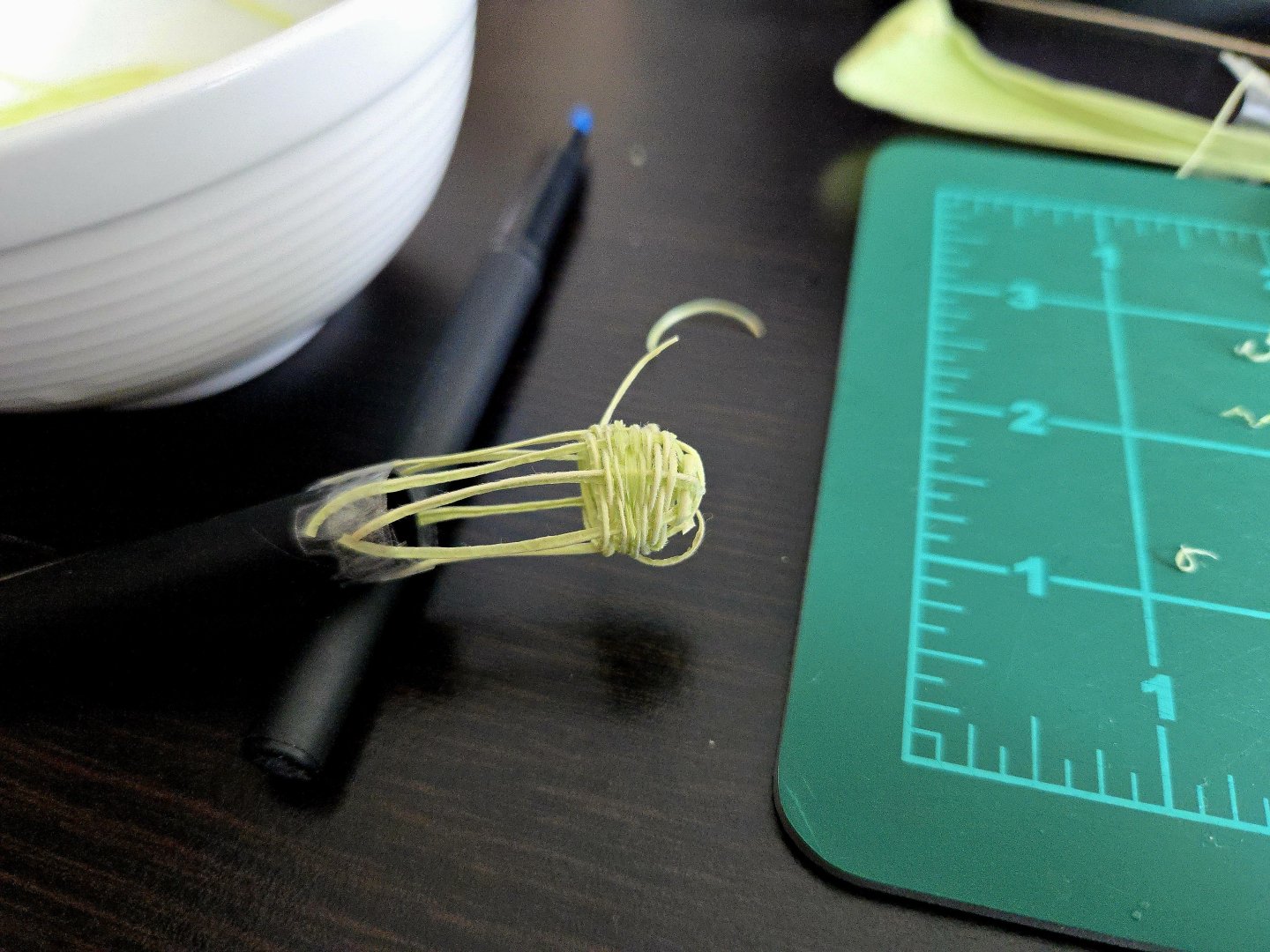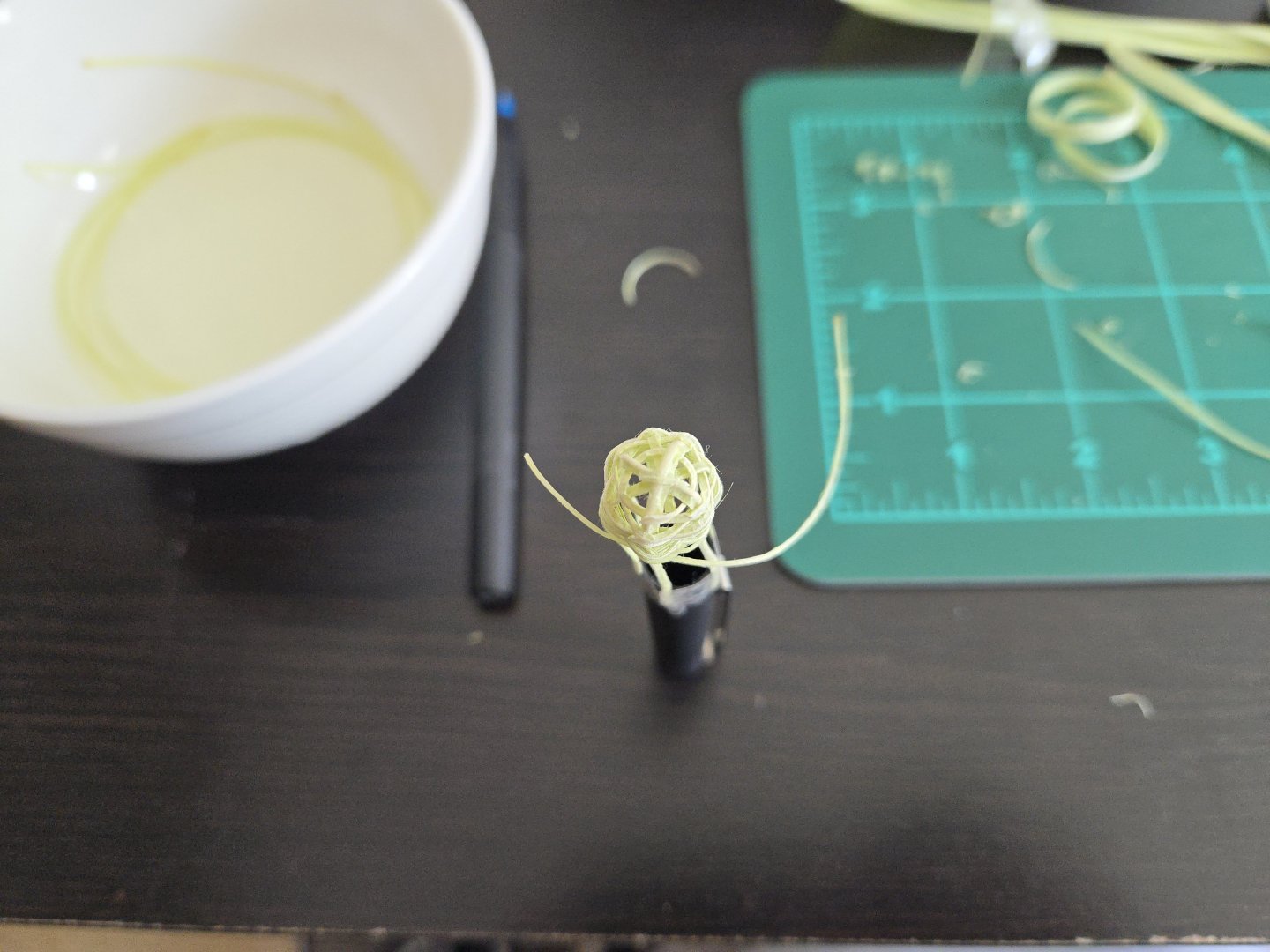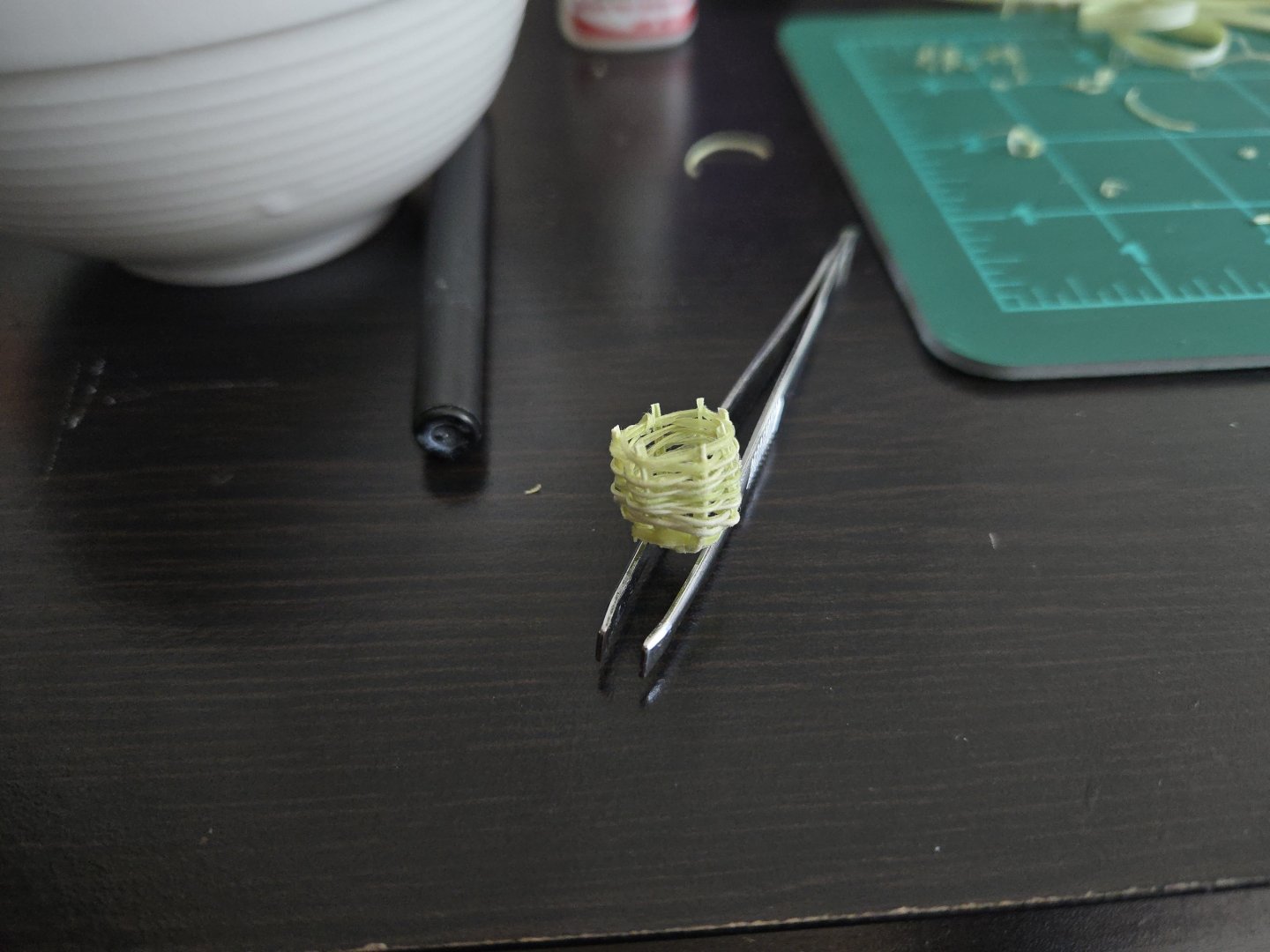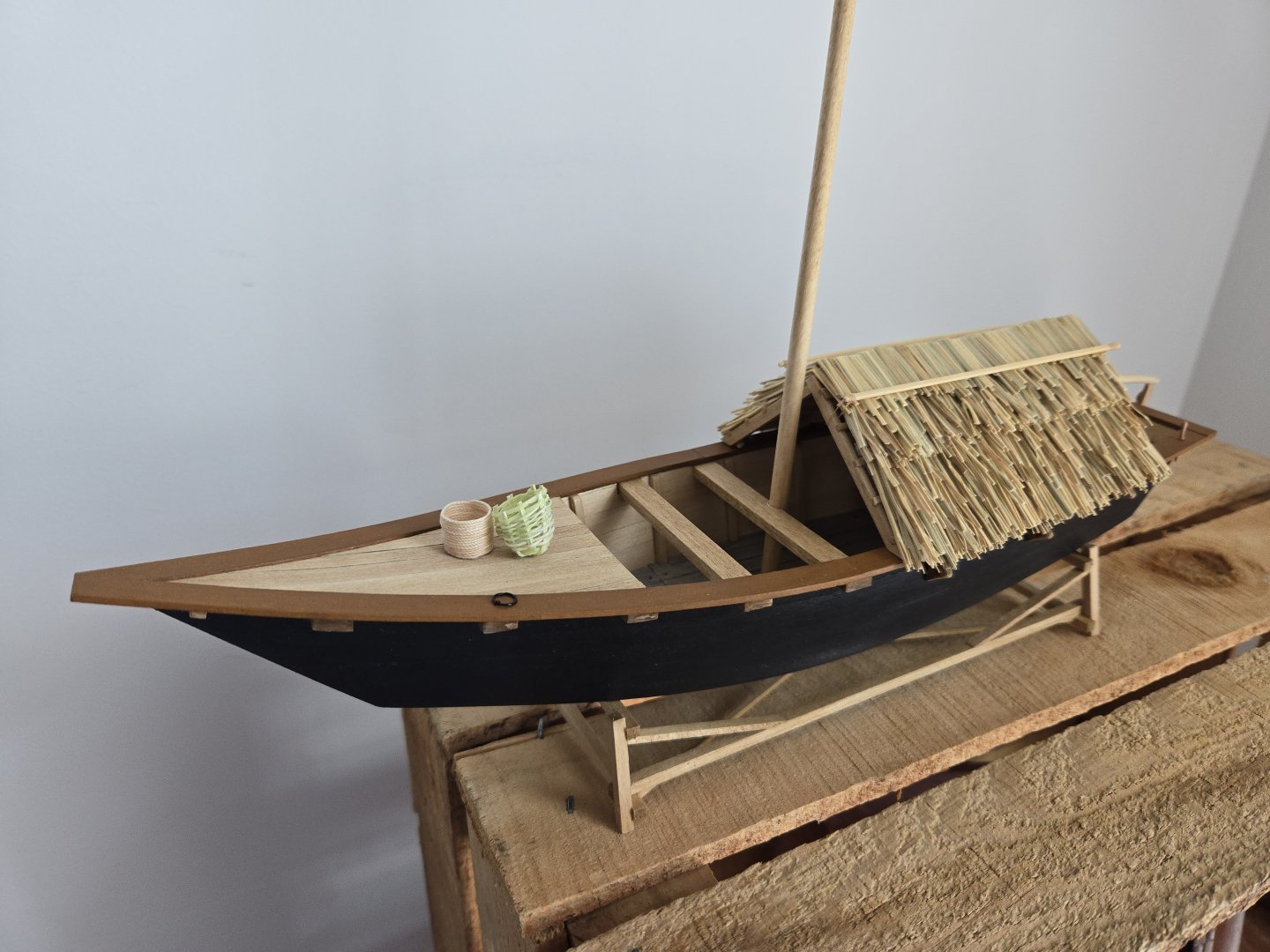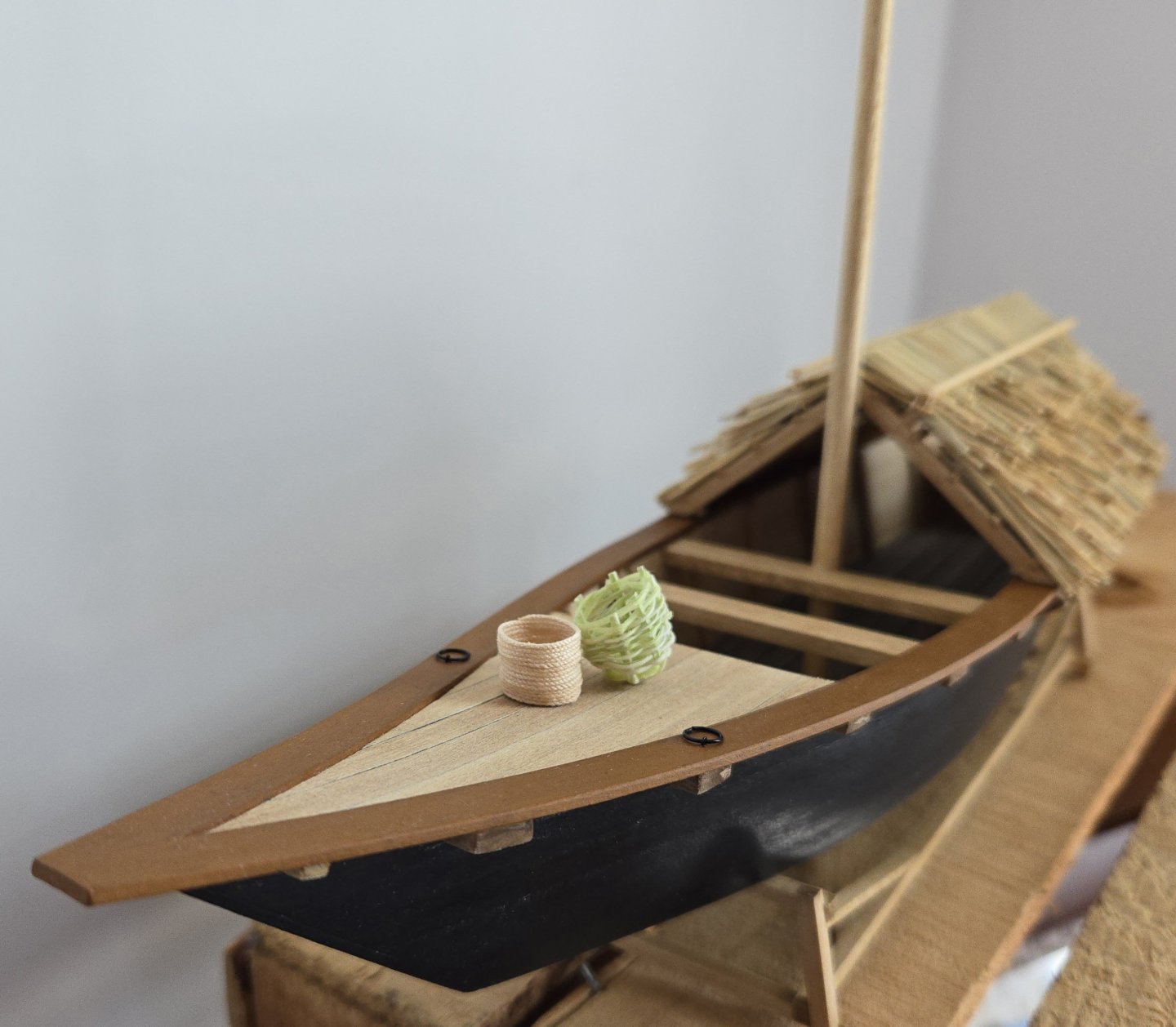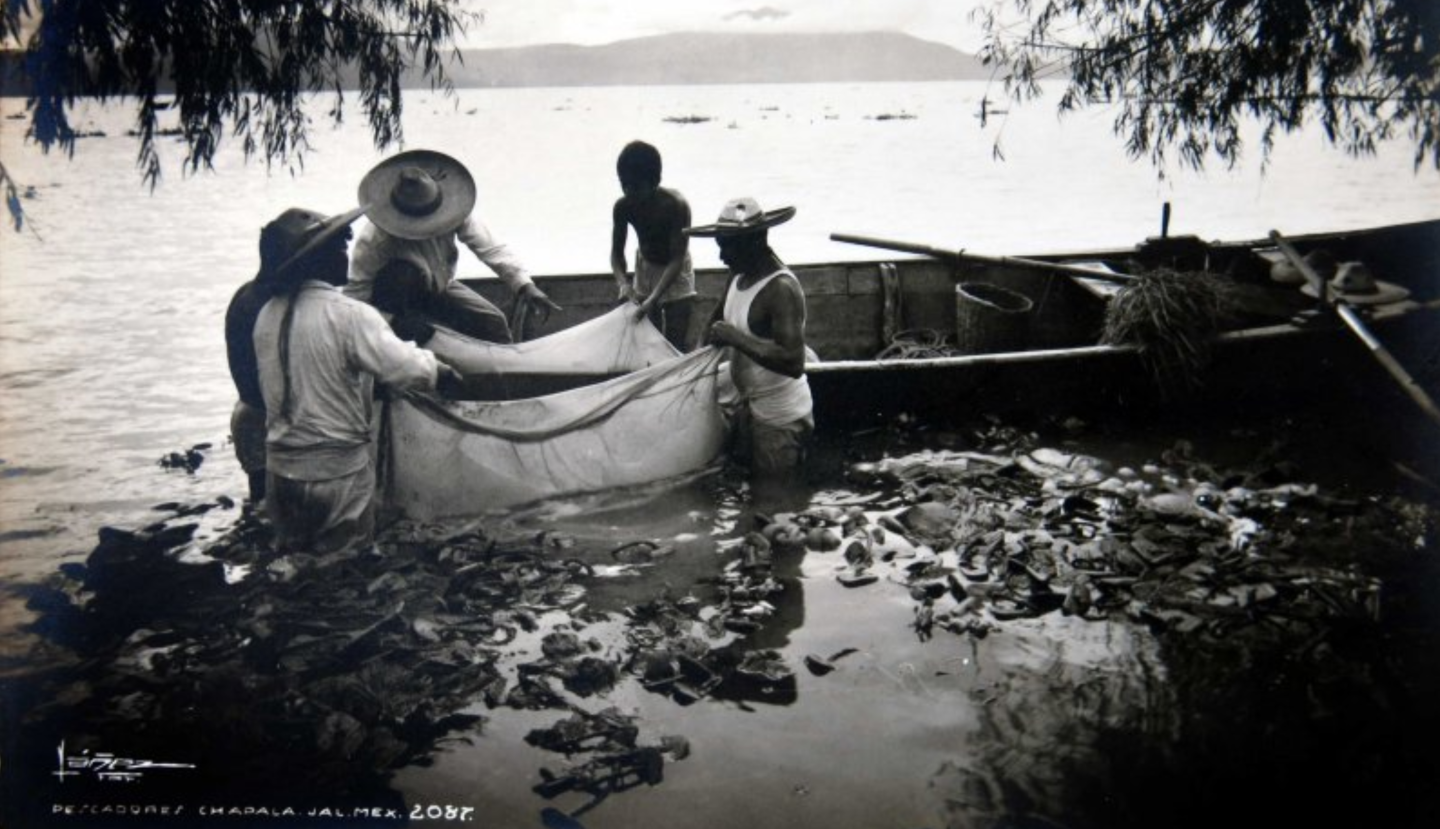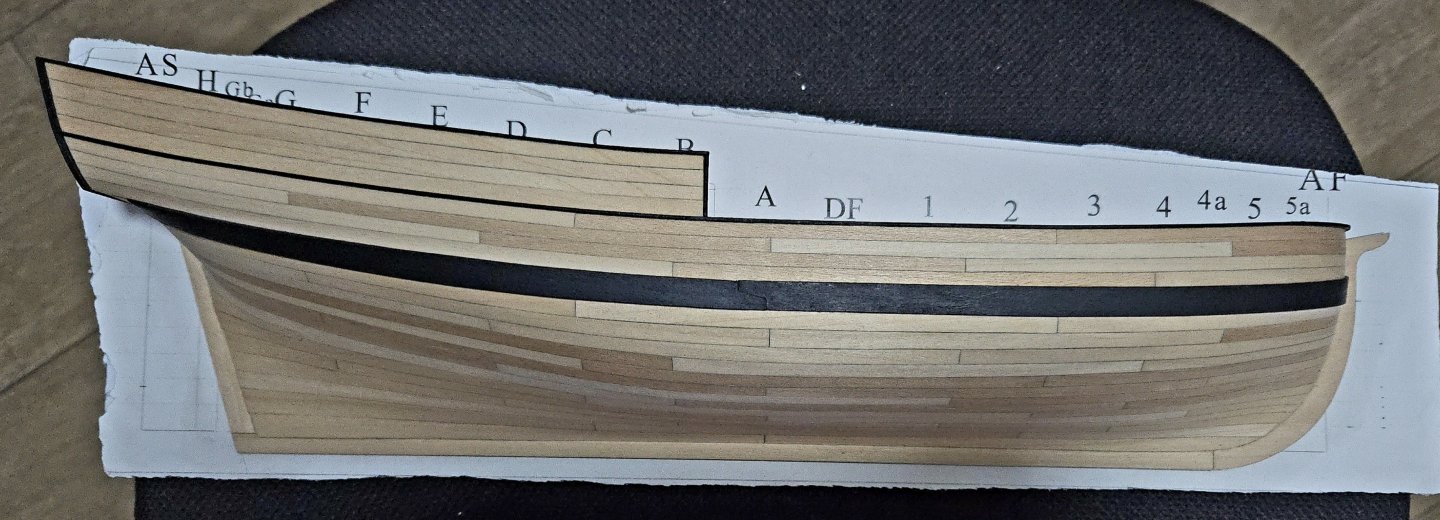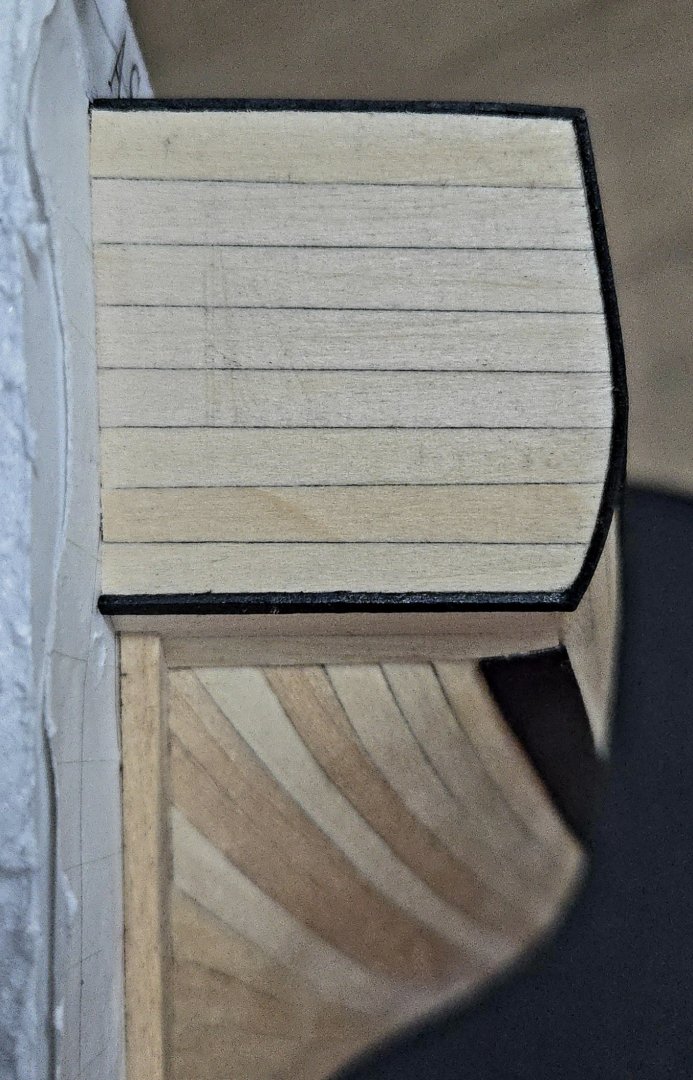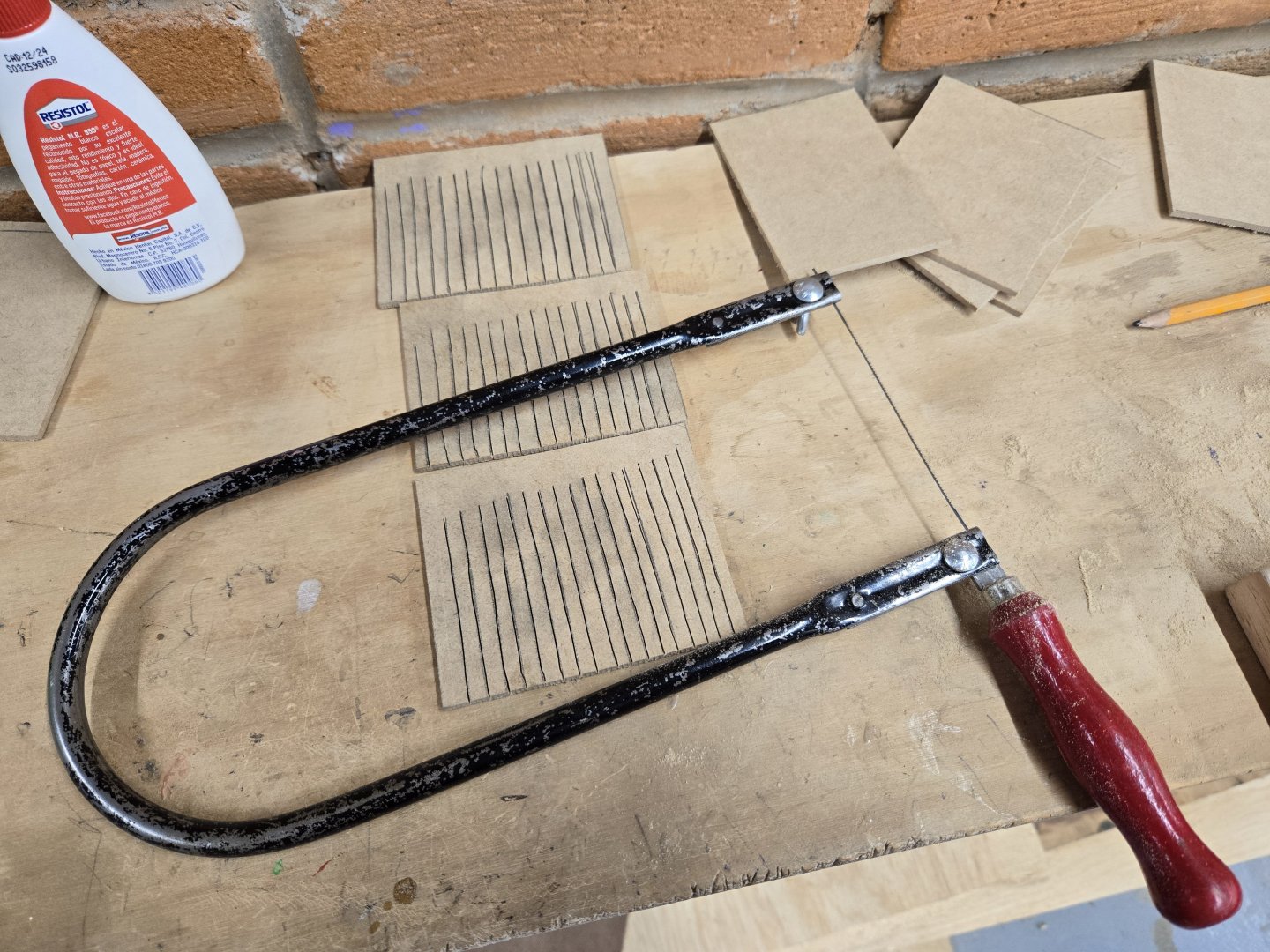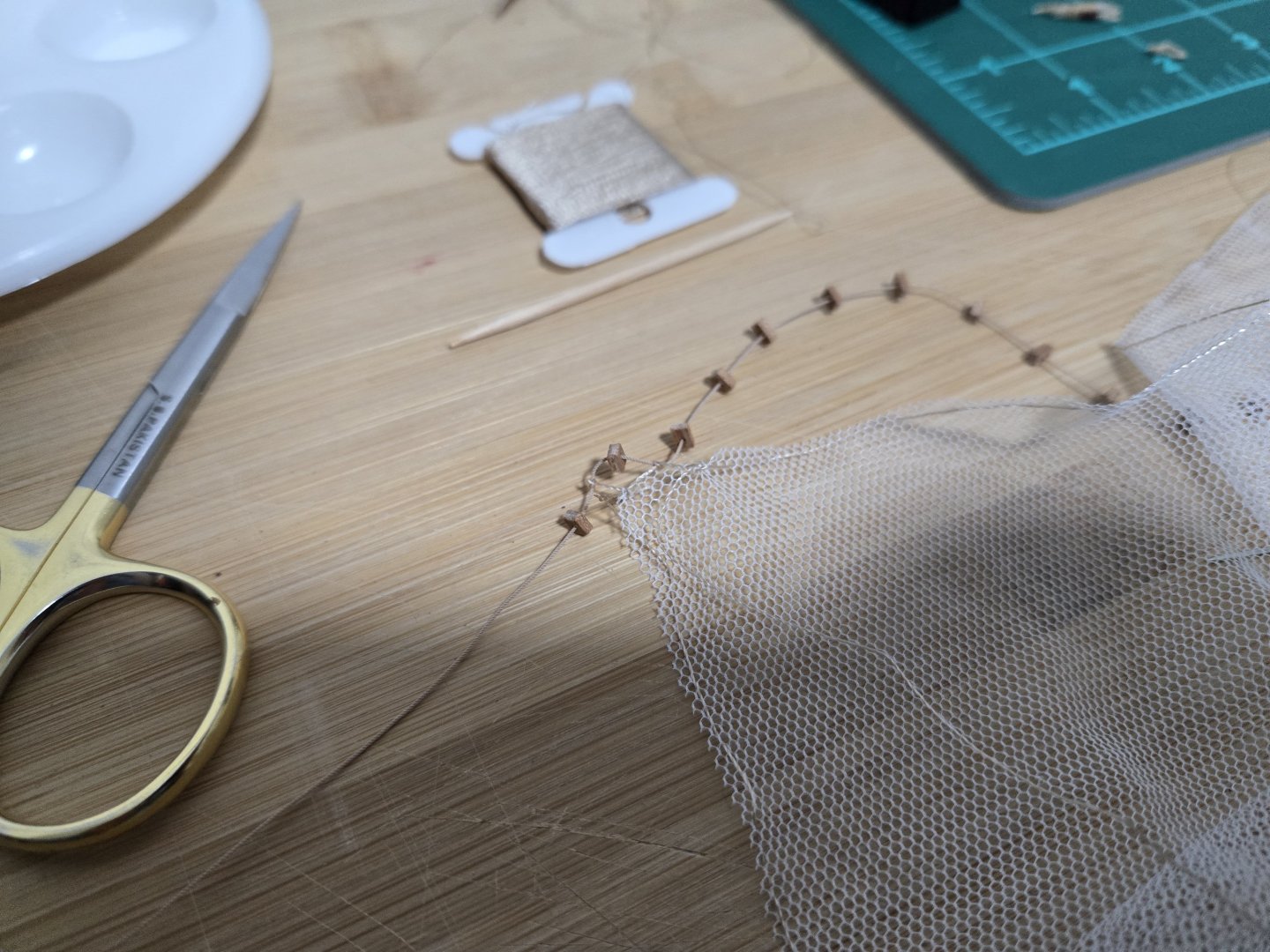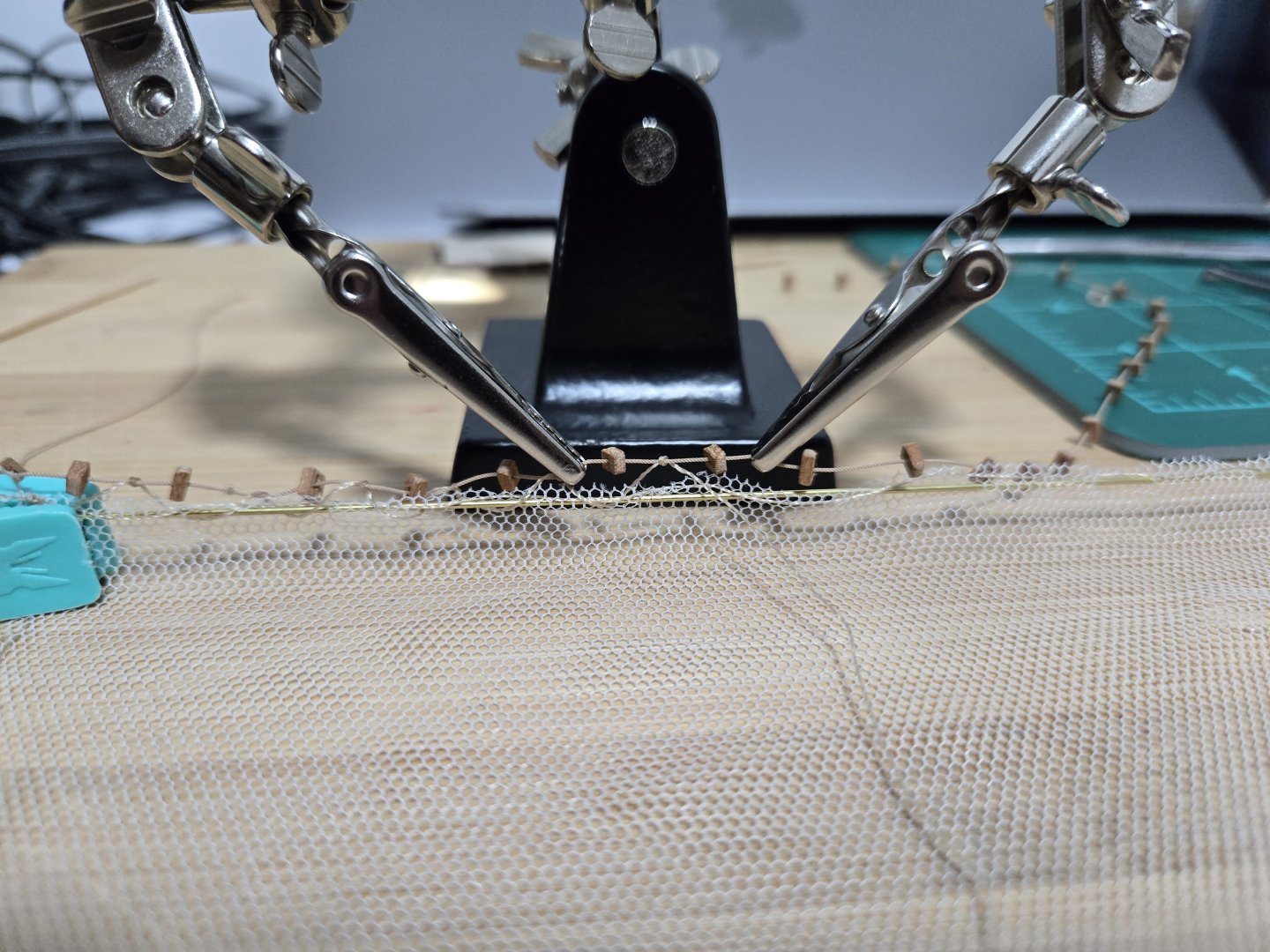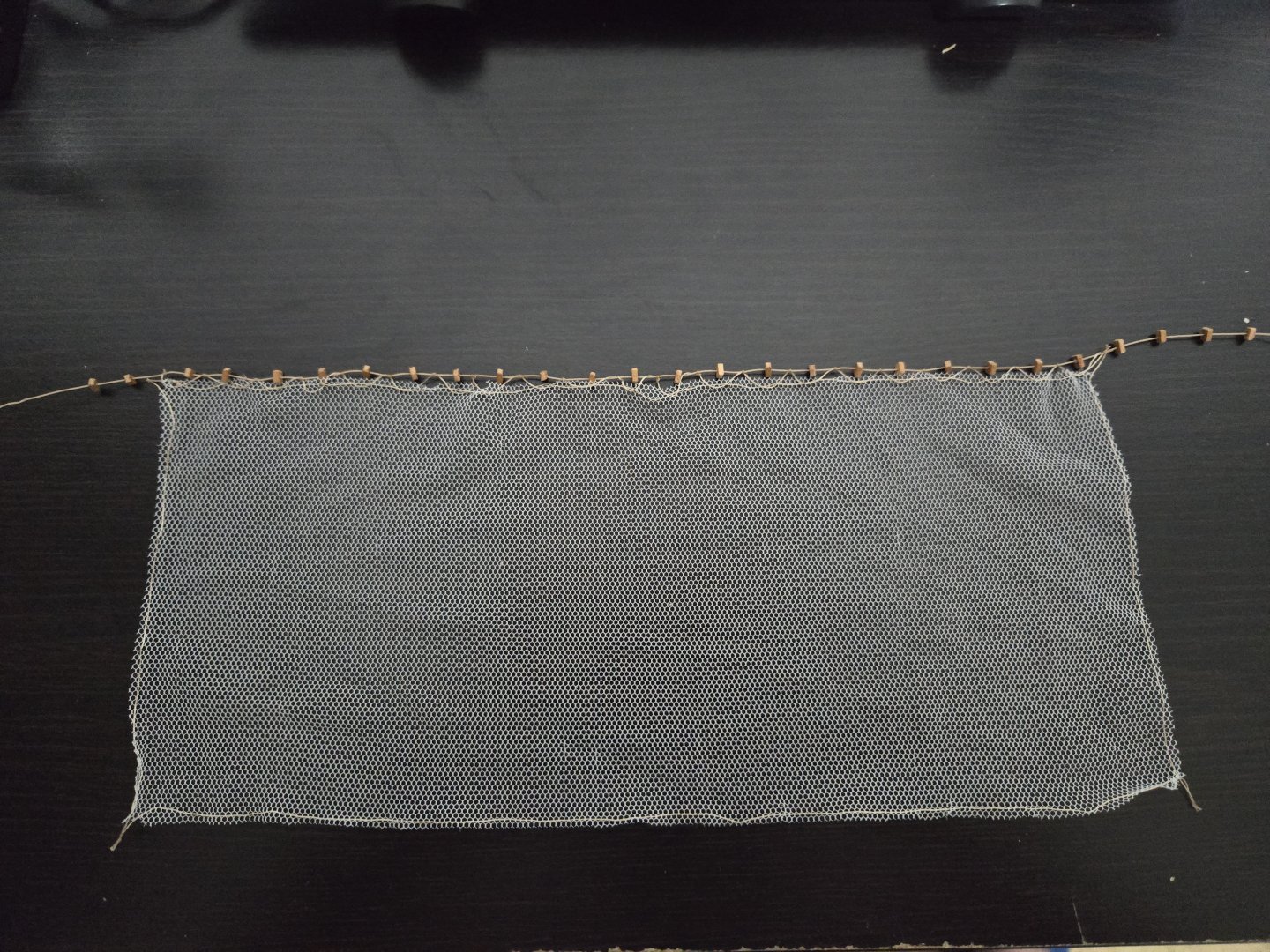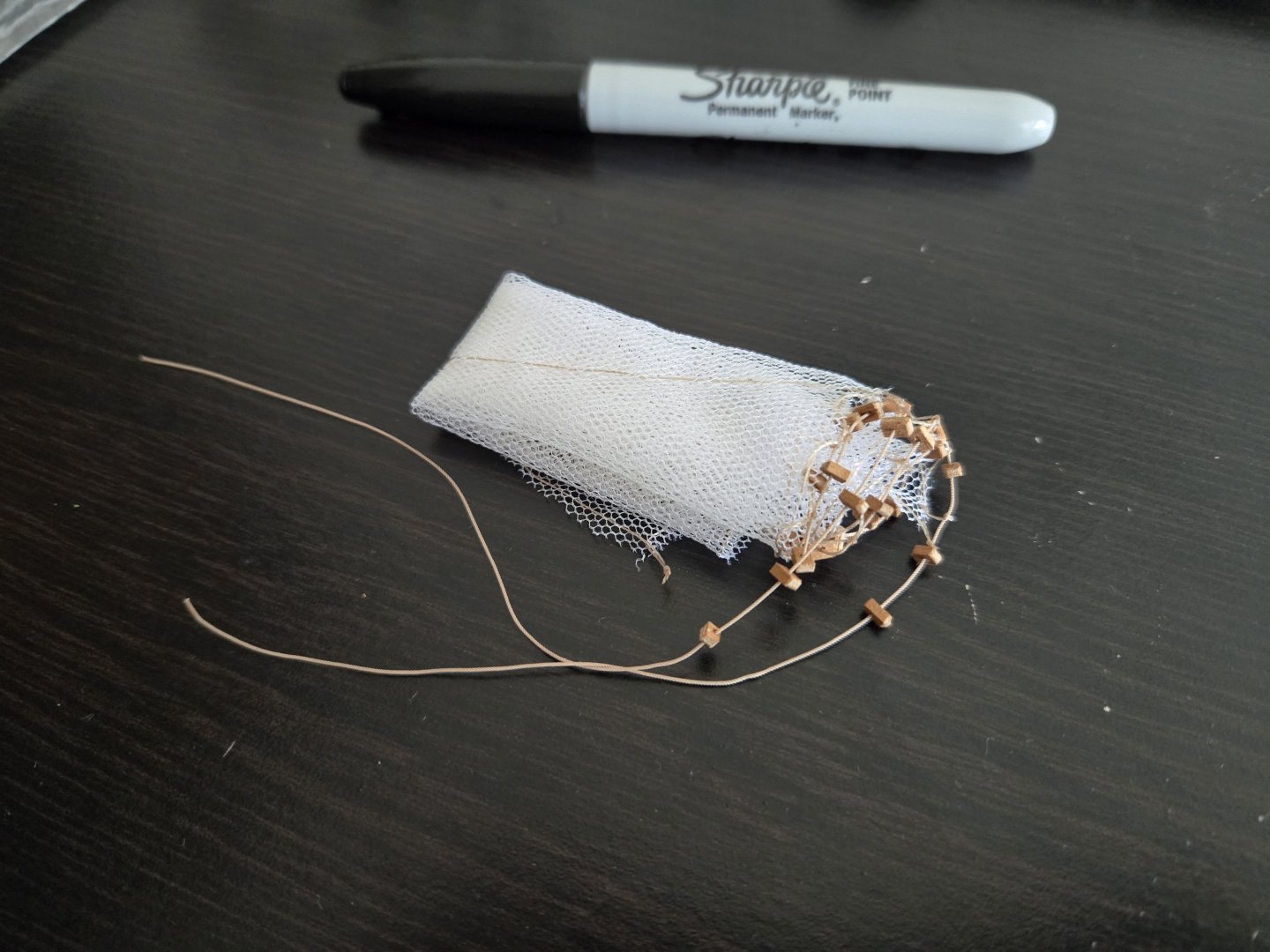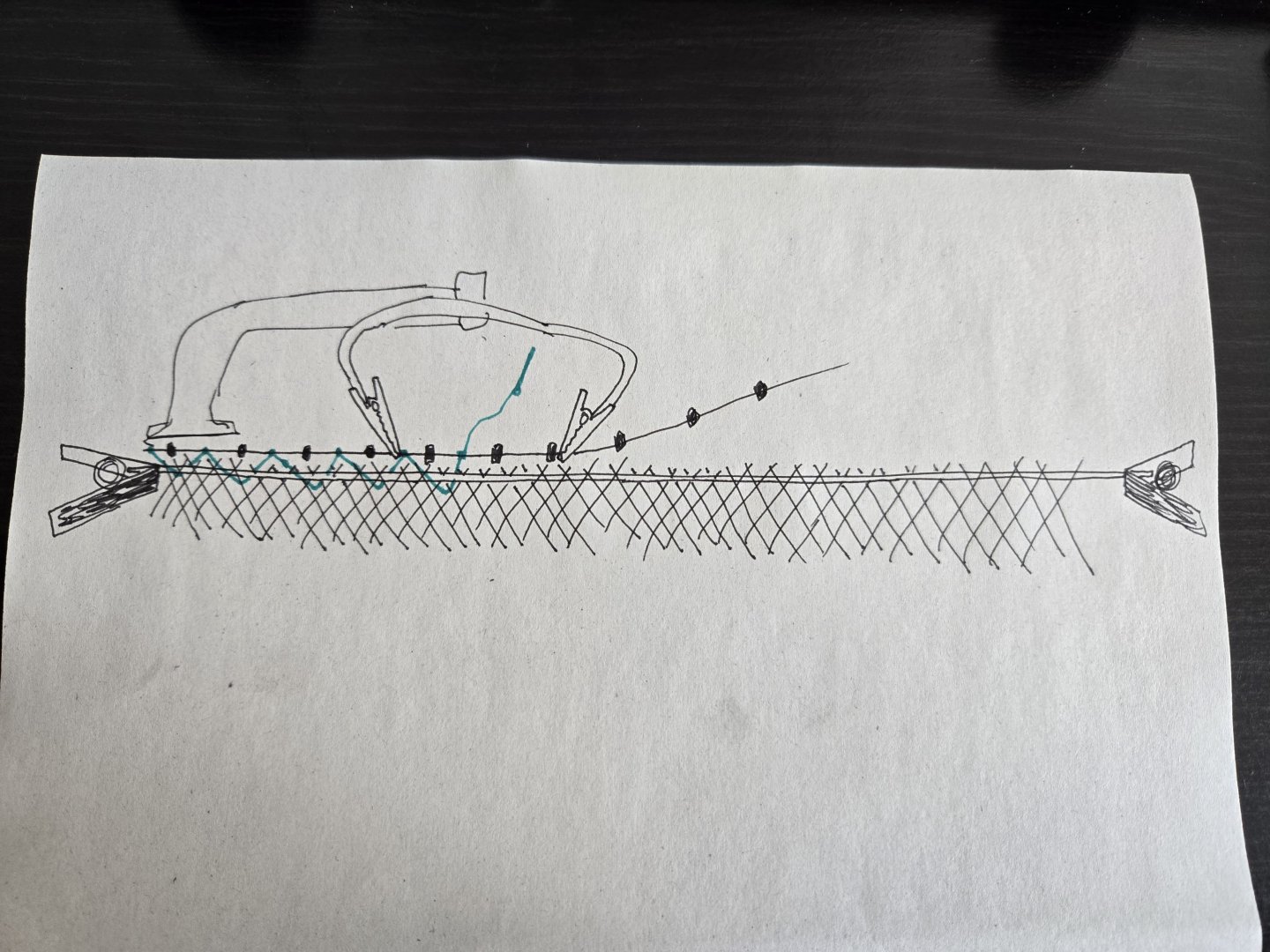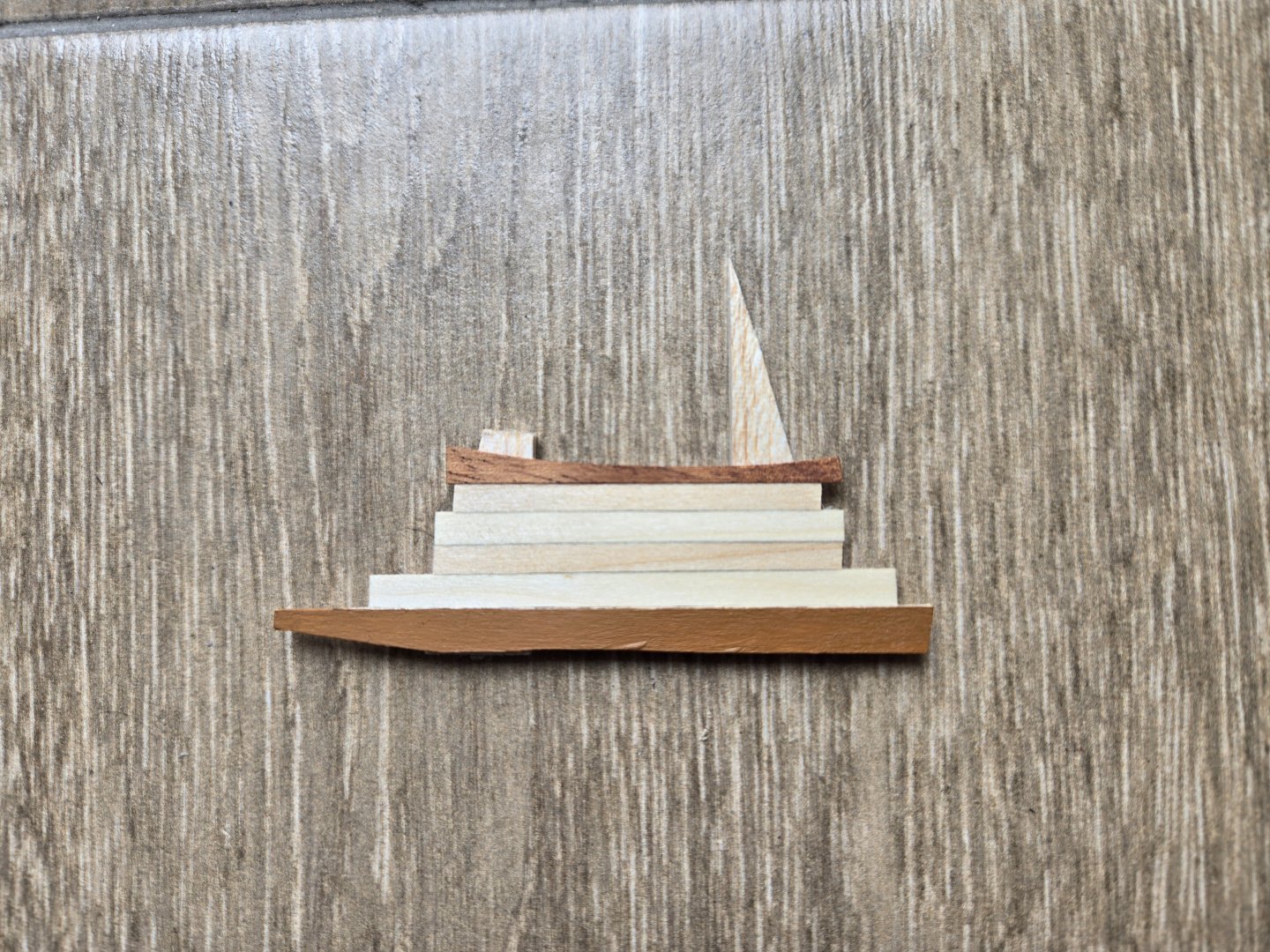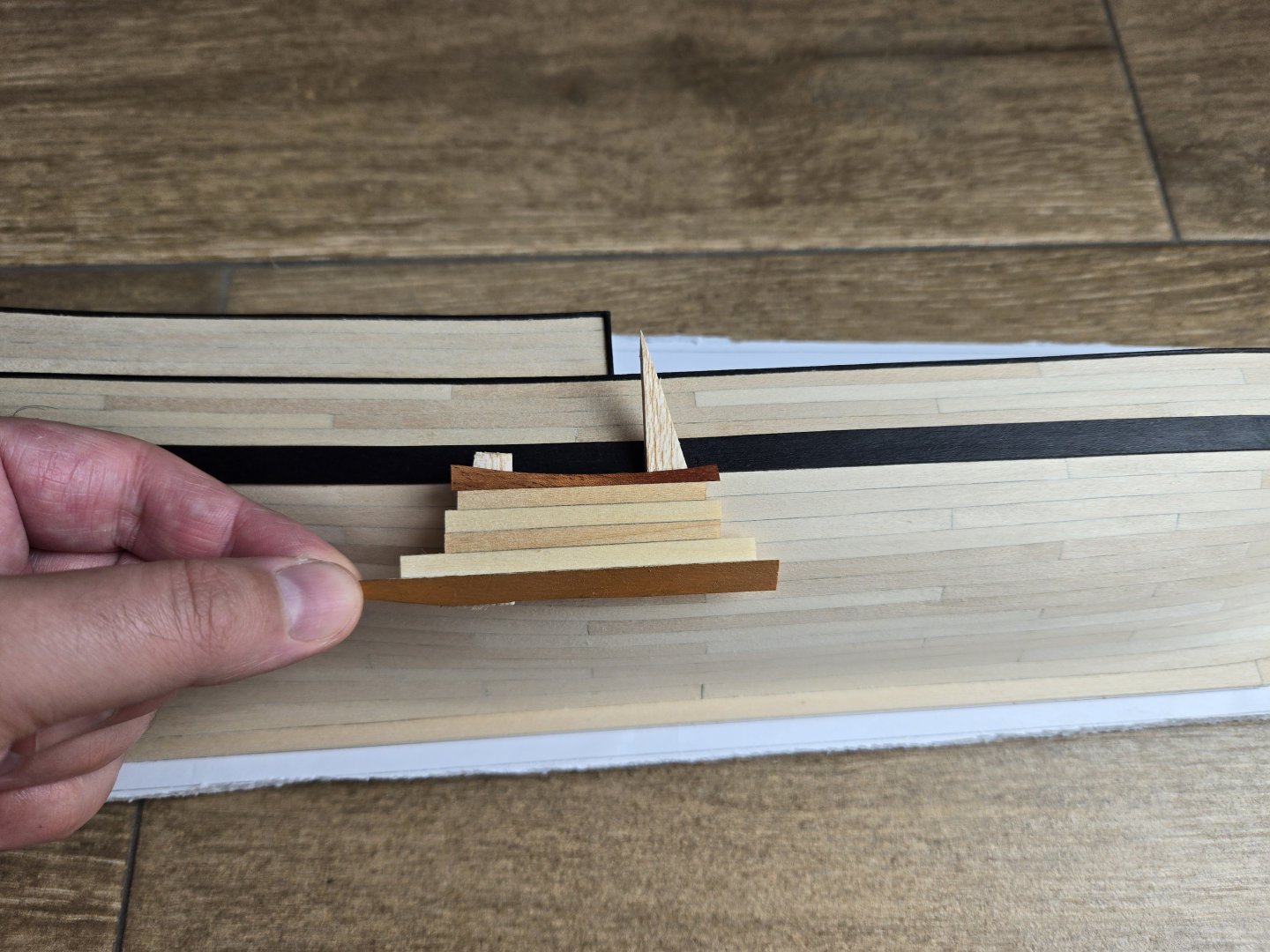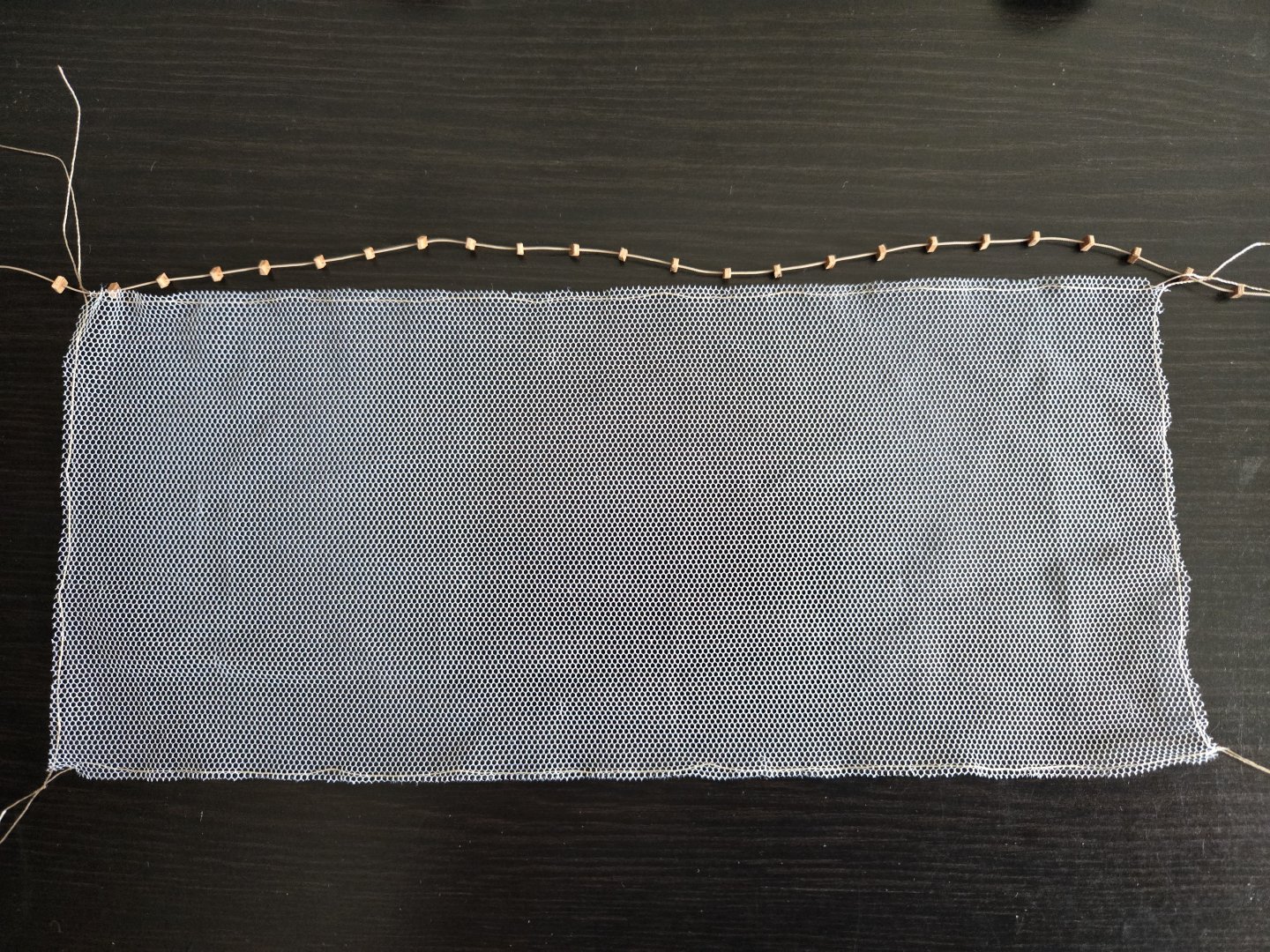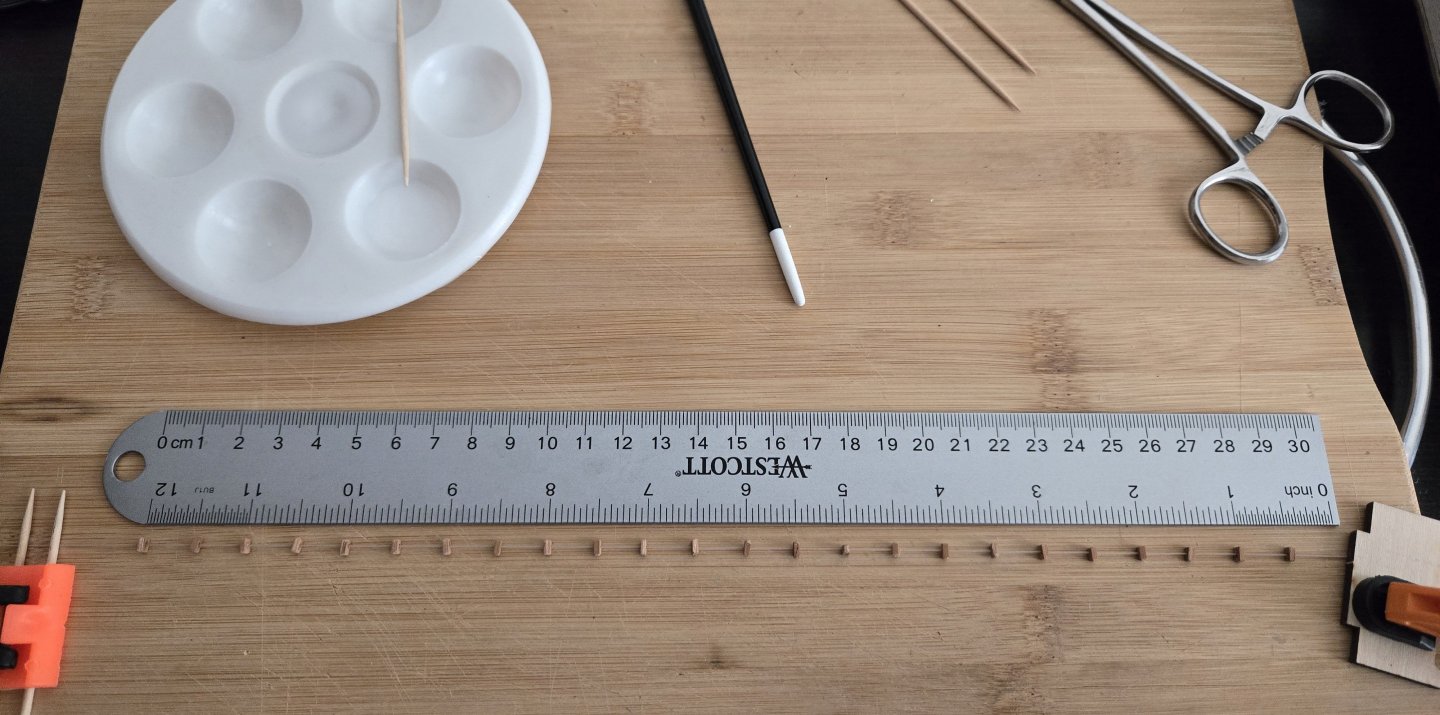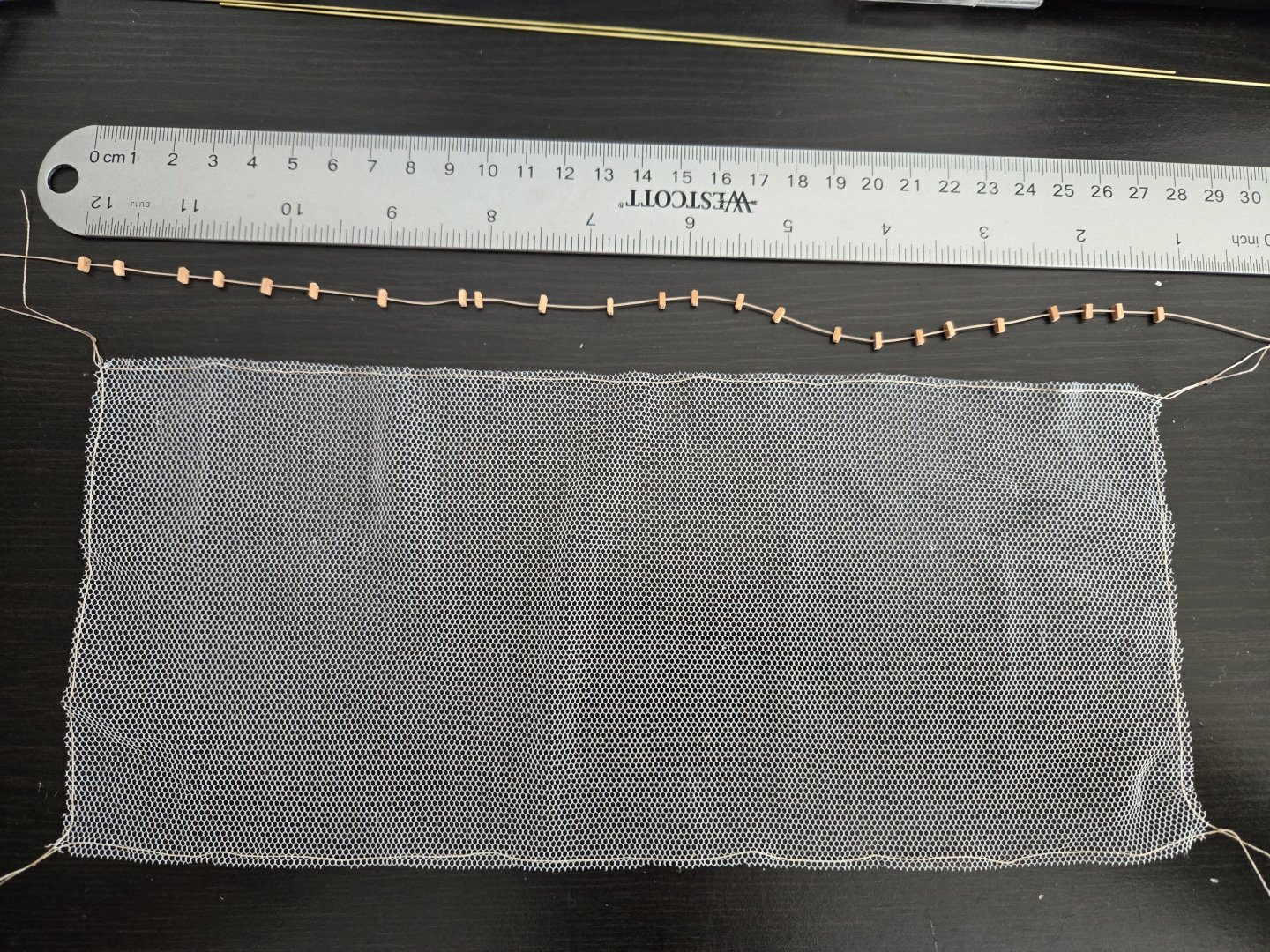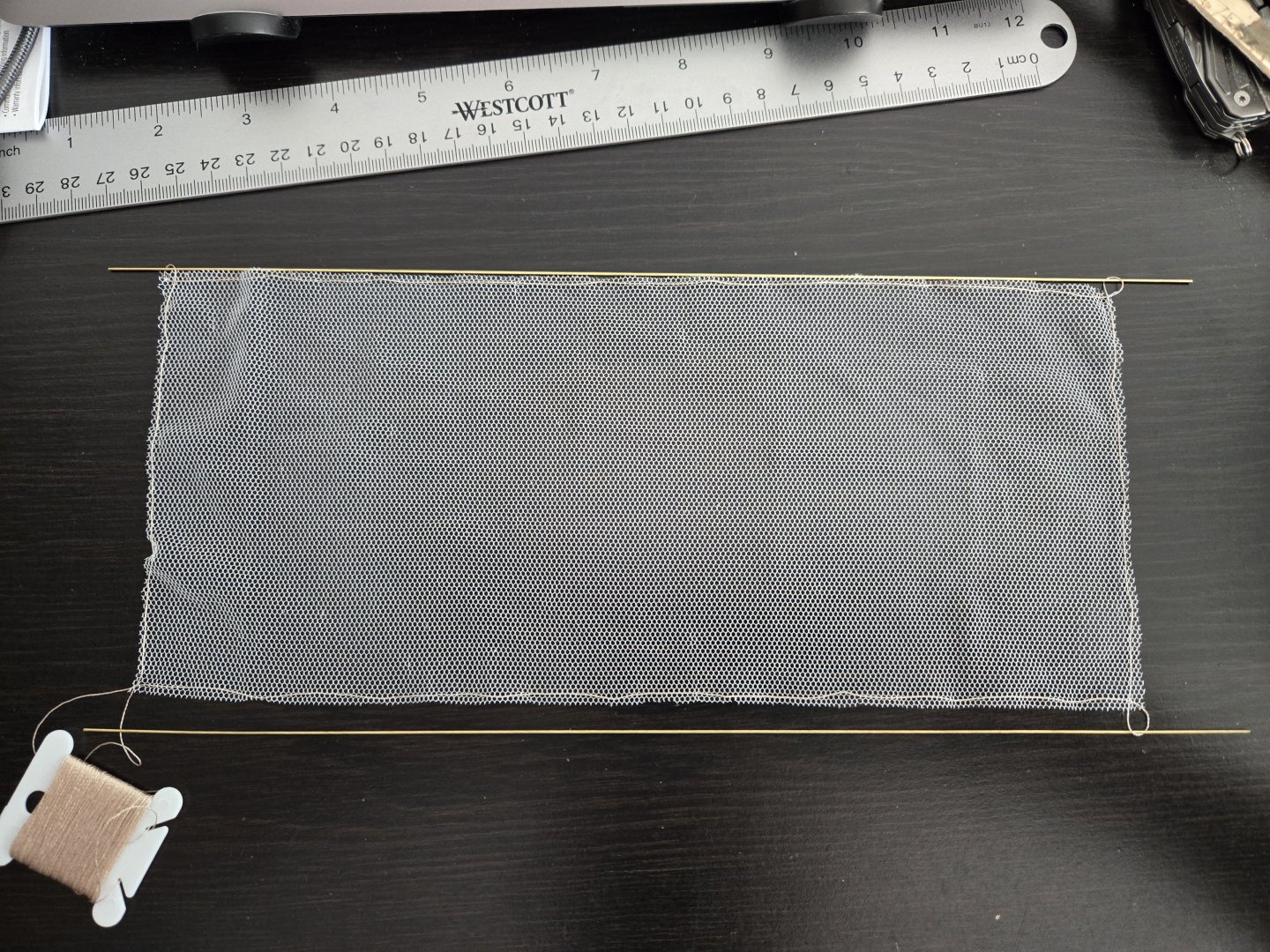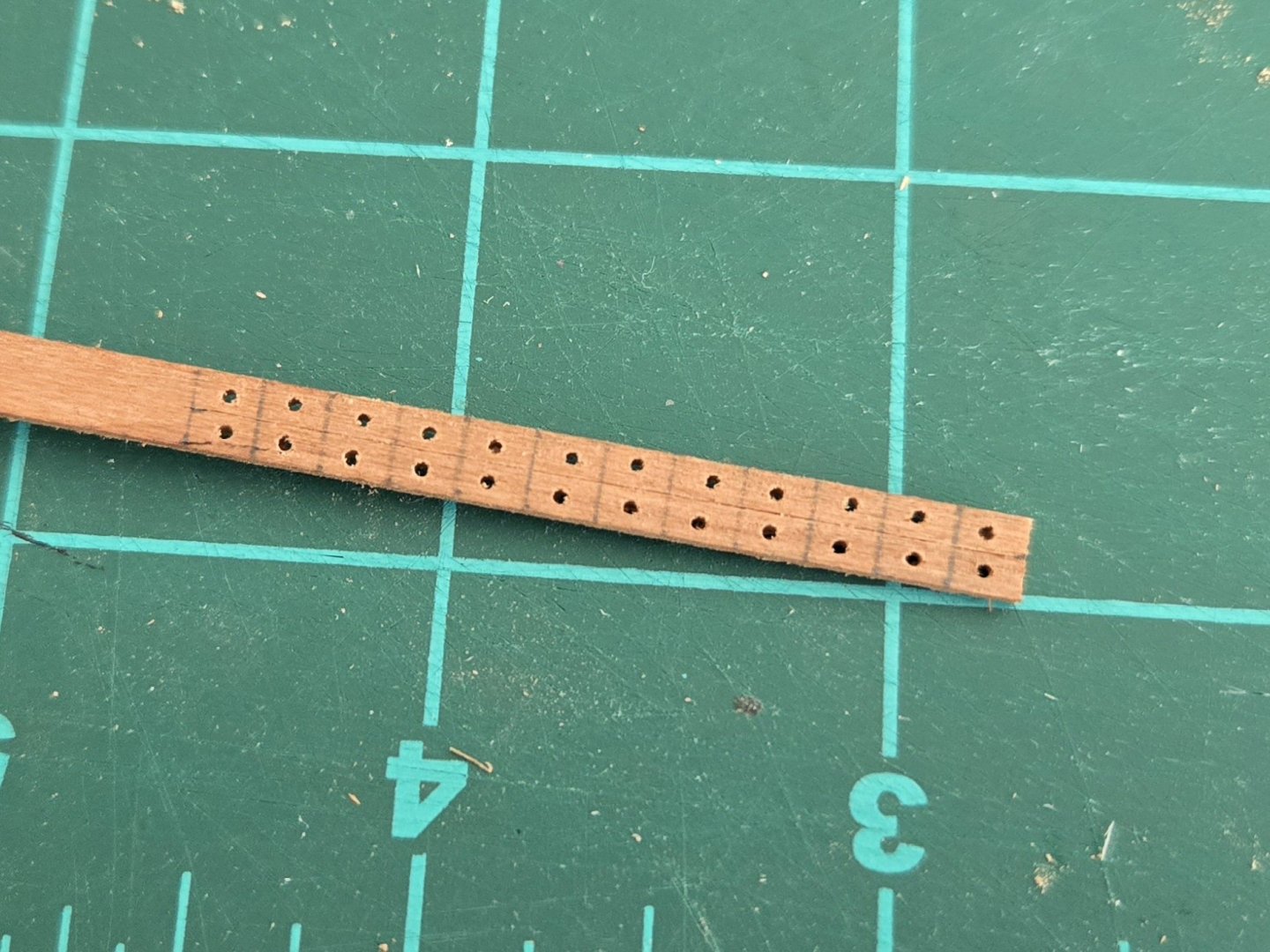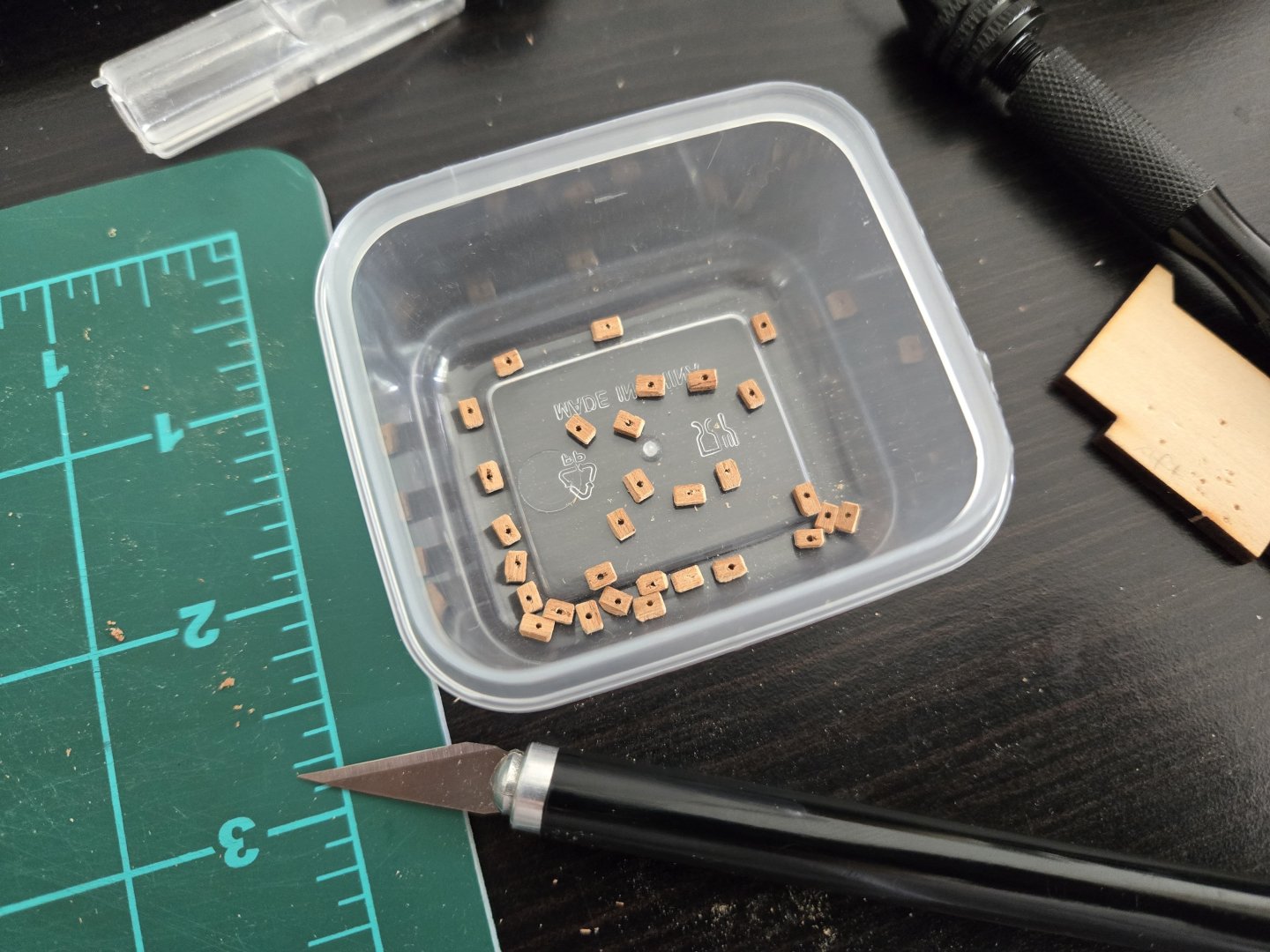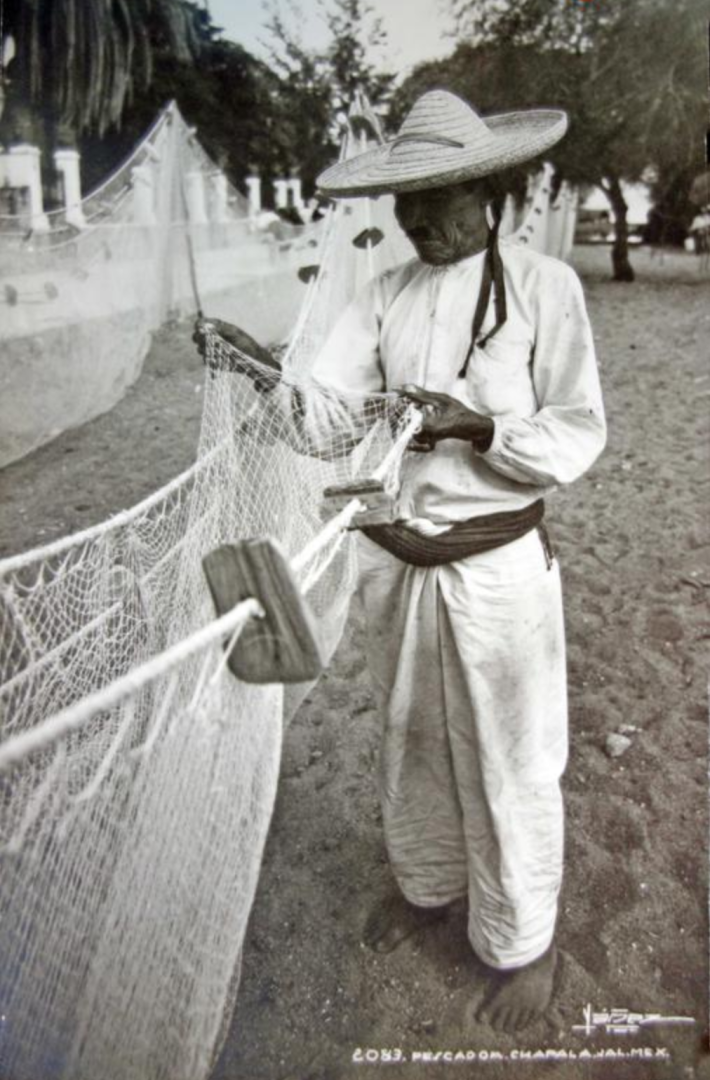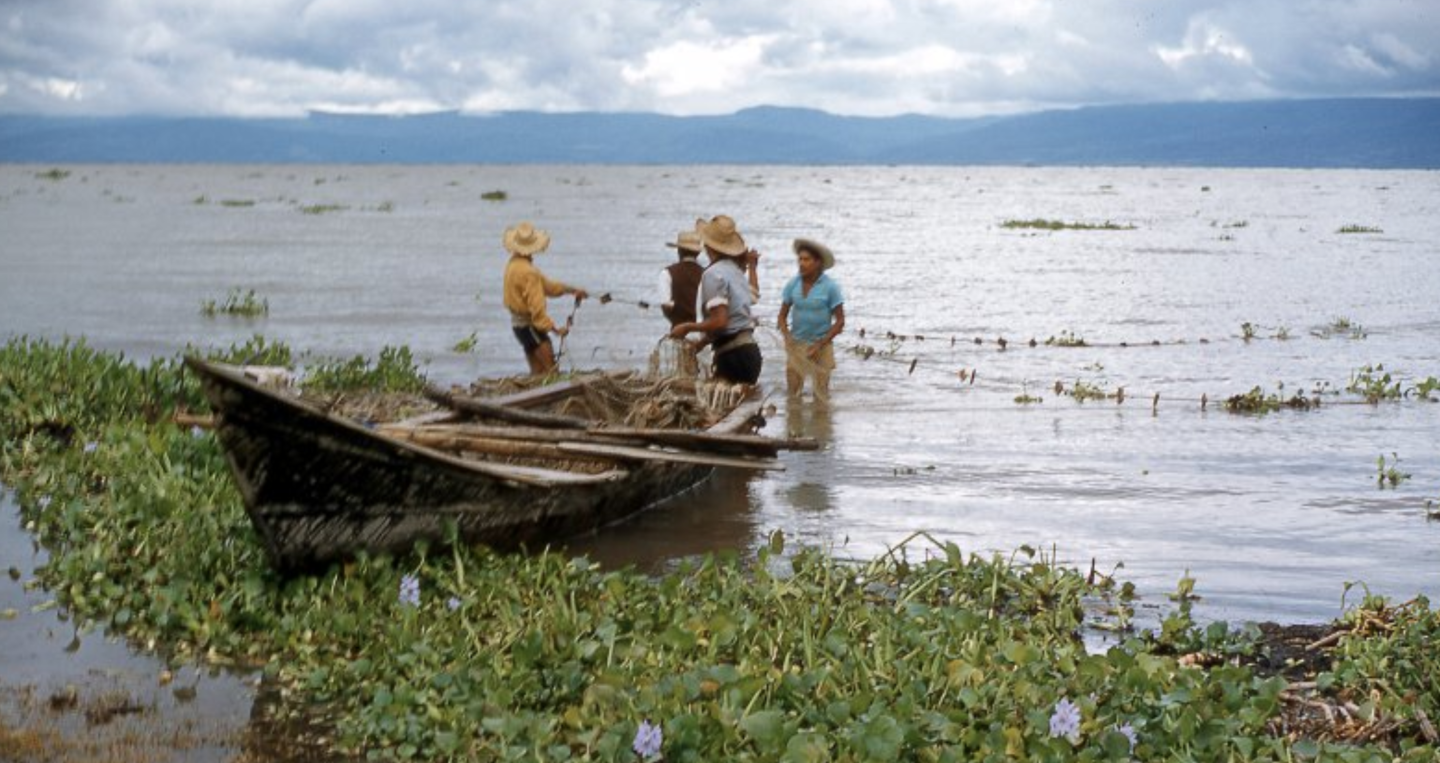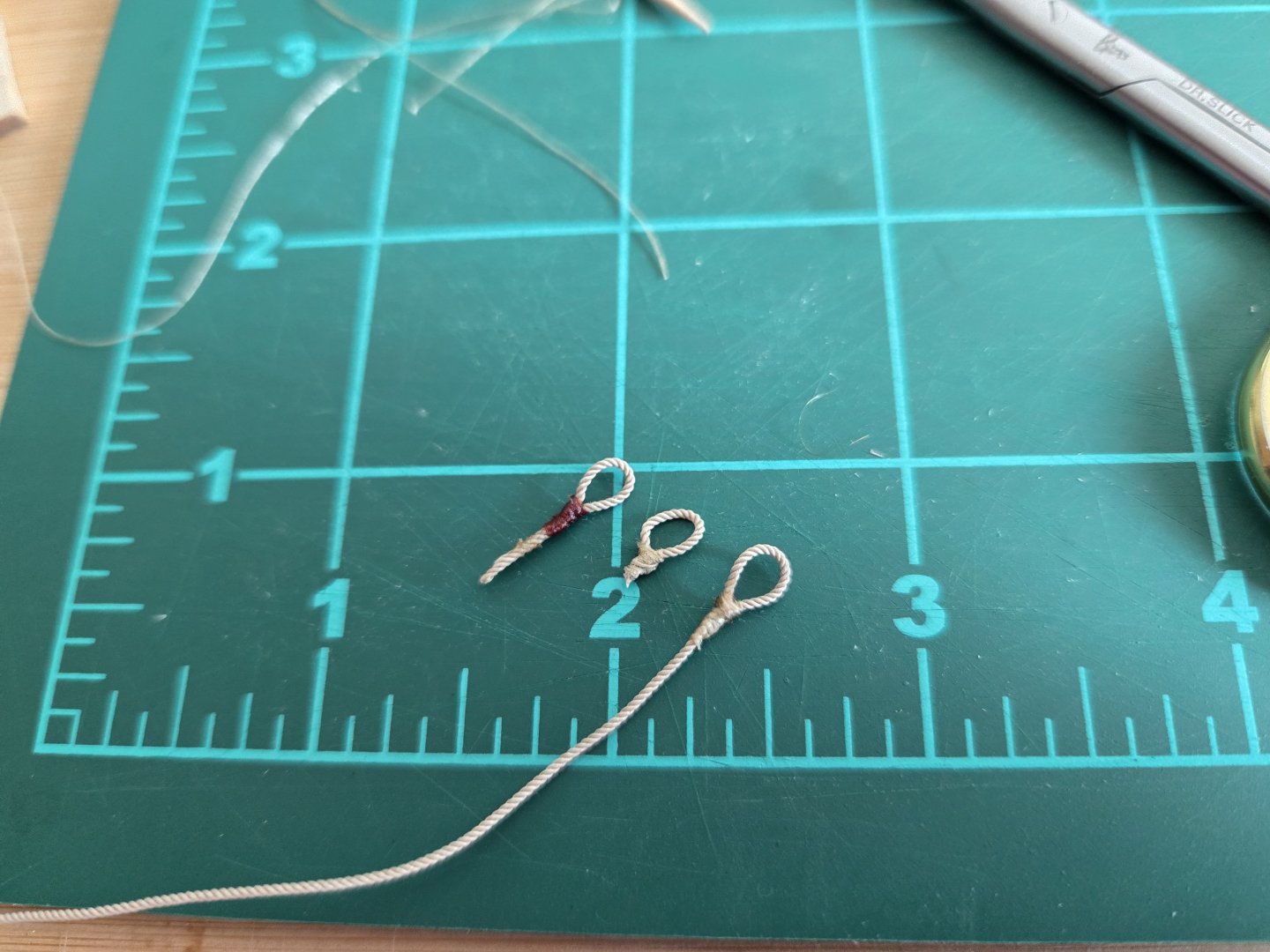-
Posts
1,309 -
Joined
-
Last visited
Content Type
Profiles
Forums
Gallery
Events
Everything posted by JacquesCousteau
-
More progress on the fishing gear. The main other type of net I wanted to include, besides the chinchorro, was an atarraya (cast net). According to Ortiz Segura, these were usually 2-4 meters in diameter, and were used largely for catching mojarra (using a net with large holes) and charales (using a net with small holes). As with other nets, these were made by fishermen (and, I suspect, their families) by hand. I was able to find diagrams of cast nets online. The first step was to cut an appropriate-sized circle of tulle mesh and weave a sort of "bolt rope" (usually called a lead line, although I assumed that the weights would be stones tied off around this like on the chinchorro rather than lead) around the edge. I used .35mm rope from Ropes of Scale for this. As can be seen, I marked out the circle and important lines on a sheet of paper, and used tape to temporarily hold the tulle steady. I then added the other parts, first placing a ring (apparently called a horn) in the center of the net, and then attaching brail lines. The brail lines run from the lead line at the edge of the net through the horn, and when pulled by the hand line they're tied to, they draw the net shut. I used nylon thread for all of these lines. I simplified the number of brail lines that would probably be used, as the net will be folded up in the Canoa. I then ran the brail lines through the horn, tying and gluing them together. Next, for both the atarraya and the chinchorro nets, I needed to make the weights, which Ortiz Segura describes as tied stone. Following Wefalck's advice, I cut up a bit of cork into small pieces to make stones. Given their tiny size, they were a bit tricky to hold to paint--after a first attempt at using washes to color them, which largely failed in part because I forgot that cork floats, I just dabbed paint on them. I used a grey that I incompletely mixed from black and white so that there were some color variations. I think they turned out as pretty convincing stones! Tying lines to them was a challenge, given their small size and my general clumsiness with knots (I'm quickly finding that I much prefer the woodworking aspects of building to any sort of rigging). I decided to use a dab of superglue to hold the rope--in this case, fly-tying thread) in place. The first attempt was a disaster, as the tiny cork stone first stuck to the glue brush, then to my tweezers, then to my finger, and then to my table. I then realized that the smarter way to do this was to put the stones on a strip of tape, and then dab on glue and attach the thread, only removing it from the tape afterwards to tie it. Originally I planned on doing a proper lashing fully holding the stone in place, but I found it very difficult to tie them at different angles and ended up just doing a few simple knots around each. Close enough. These were then sealed with glue and the excess trimmed. I used clove hitches to attach several weights around the perimeter of the atarraya and along the bottom of the chinchorro. I found this step tricky. No matter how closely I held the stone to the bolt rope/lead line, the stone always seemed to hang lower than I wanted. I decided not to worry about it, as the nets will be folded up. I also didn't add as many weights as there probably should have been, again because many will be obscured by the folding of the net. The results can be seen here--a lot of work for such a small detail! To complete the nets, I painted them with a brown acrylic wash, to tone down the white of the tulle. It's hard to see against a black background, but easier to see in comparison with unpainted tulle (or in this case, partly painted--the irregular piece was my test). All that's left for the nets is to fold them up and make a loop of the atarraya's hand line. Finally, I also painted the anchor, given that it didn't change color at all from blackening. I just used acrylic paint, touched up any chipping once it dried, and the covered it in matte varnish to protect it. The finish line is in sight. I'm enjoying this build a lot, and have learned a lot as I go. But it's taken much longer than I originally planned--I originally thought I could do it in a few months!--and I'm looking forward to some other projects that I've decided not to get into until this one is finished. (Not to mention that I still need to finish the Maine Peapod's oars and lobster trap, and mount the Half-Hull on a frame).
- 286 replies
-
I think it might be this post: That said, it's aimed mostly at a complete beginner, and it sounds like you already have some experience. You can use your judgment as to what makes sense for your skills, display space, etc. And for your interests--no point in choosing a kit that's not actually interesting to you.
-
Thanks Chris! That's exactly how it works, just with an opening at only one end and a row of spikes instead of a net funnel.
- 286 replies
-
Thanks! According to Ortiz Segura, the nasa was used to catch mojarra (a type of chichlid), catfish, pescado blanco (a larger variety of the chirostoma genus, which also included the tiny charales which were caught in fine nets), and other larger fish.
- 286 replies
-
I forgot to add a shot of the nasa on deck alongside the rope bucket (now given a dark brown wash) and the gangplank (also colored with washes).
- 286 replies
-
Thanks, Glen! Wefalck, I was sure I had seen someone's woven baskets on some build log but couldn't find it, I should have guessed it was your botter. The baskets look great, and I may try again with some different materials. I decided to build on my first corn husk basket experience. With the material, it was difficult to get a very tight weave. But I noticed that, while the baskets I've seen in photos seem fairly tightly woven, there was another fishing tool that wasn't so tightly woven: the nasa or fish trap. These were essentially large woven baskets in the form of an egg, with an opening at one end and various pointed stakes positioned inside to bar exit to any fish that enter. Here we see an image from the Ortiz Segura article of the last nasa-maker in Chapala: Source: https://www.ugr.es/~pwlac/G17_26Carlos_Ortiz_Segura.html And here we see a variety of sizes of nasas (and other nets) in the Chapala fishing display at the Guadalajara Regional Museum: Source: https://lugares.inah.gob.mx/es/museos-inah/exposiciones/sala-piezas/10855-10855-instrumentos-utilizados-para-la-pesca.html?lugar_id=480&expo_id=9850 The nasa was one of the most common fishing implements in use on the lake, so I knew I wanted to make one. And the rather large weave (which undoubtedly allows water to easily drain) would be easier to make out of cornhusk than a more finely-woven basket. I decided to use nine stakes instead of the seven on my practice basket, and I spaced them evenly around the end of a sharpie permanent marker. I then began weaving. Learning from my first try, I cut the cornhusk fibers thinner this time. I was able to get a much tighter weave than on the practice basket. Once I reached about the midpoint, I had to remove the nasa from the marker "jig" and glue the ends of the stakes together so that I could properly tighten the perimeter toward the opening. Without the marker to shape the nasa, this part was a little trickier to weave, but the base was pretty solid. Finally, I trimmed the loose ends of weaving material, and turned over the stakes--those that "emerged" out of the opening were properly woven around the edge and back into the interior to secure the mouth of the nasa, while the others were just folded inside. Overall I'm pretty pleased with how the nasa turned out. It would be nice of the opening was a little smaller, but it needed to be large enough for my tweezers to fit in. I'm hoping that the color will become more gray-tan as the cornhusk fibers continue to fully dry. I may give it a dip in wood stain if not. All that's left for it is to attach its line and marking buoy.
- 286 replies
-
Welcome! Fishing boats are a great subject for modeling. There are quite a few kits to choose from. A lot of different manufacturers have kits of the Bluenose with variations in size/scale, accuracy, and level of detail. Model Shipways has a fairly large scale model of the Benjamin Latham. Bluejacket also has kits of several fishing schooners, including Smuggler and We're Here. I'd recommend looking at build logs for all of them to get a sense of each kit and any potential issues.
-
Congratulations, that looks great! I love the touch of red in the cockpit.
- 37 replies
-
- Model Shipways
- muscongus bay lobster smack
-
(and 1 more)
Tagged with:
-
Next, I thought I'd work on some baskets. As far as I can tell, these were used to store caught fish. A woven basket appears in this image: Source: https://www.mexicoenfotos.com/MX14140215743756 I've tried two methods for making this. First, I made a simple rope coil basket out of yarn held together with glue. I began by making a tight coil for the bottom, making it flat on a strip of tape sticky-side-up and soaking it in diluted white glue. I then continued the coil upwards to make the sides, again using white glue. Nothing too challenging, although it required a bit of attention to keep the bucket sides from falling inward (and I should have done more to make them flare out a bit). I repeatedly paused to dab on diluted white glue, besides using undiluted glue to hold each layer on. Once the bucket seemed an appropriate height, I trimmed off the loose thread. The finished bucket can be seen below, temporarily placed in the bow of the Canoa. As far as bucket methods go, this was pretty easy, but it doesn't really look all that woven. I thought about trying to really weave something, but couldn't figure out what materials to use. The broom fibers I had used for the thatching maybe would have been a good option, but I had thrown out the remains of the broom during the move. While cleaning up after having corn on the cob for lunch, I was struck by the possibility of using corn husks. They have long fibers and are frequently used in Mexican craft goods, so it would be a nice gesture linking my work to this tradition. So, I saved a few husks and split them into thin fibers, and started work on a woven basket. I started with the stakes, forming them into a rough basket shape around a pen and securing them where the overlap with a drop of superglue. To weave, I removed the shaped stakes and taped them around a pen cap, leaving space to thread around them. My first attempt went poorly. First, I had let the husk fiber sit out too long and it was too stiff. Second, I found that nine stakes was too many to really deal with at this scale. So, I placed the fibers in a dish of water to soak, and removed two stakes so I had seven. With this, I started again. It was extremely difficult to get started, but after a good bit of frustration, I soon had a semi-credible weave going. I kept going, using dots of superglue to secure ends when I moved on to the next fiber. I found that it was much easier to weave after this, as the superglue stiffened the structure significantly. The bottom, where I had started, was a total mess, but I kept going, as I could either use this one just for practice or could place it in the model so as to hide the bottom. Finally I decided it was large enough and cut off the stakes. I'll properly trim them to size once it fully dries (which should also turn it from green to brown). Overall, it's quite a lumpy, misshapen basket, and the weave itself isn't really to scale. That said, I think this method shows some promise and I might try again, both for more baskets and, especially, for the fishtraps. The main takeaways learned are as follows: 1) The bottom is quite difficult to properly weave, and it may make more sense to fake it using the same coil method as in the rope basket, before properly weaving the sides. 2) The corn husk needs to be moist to be effectively threaded, but it does shrink a bit as it dries, so it loosens slightly. 3) One problem I had was with the stakes. They're too flexible, which made it hard to keep the basket in shape. This was compounded by my failing to space them properly evenly, which contributed to the basket's lumpiness. In the future, I may try applying a bit of superglue to stiffen the stakes, although this will require drying them first so they don't warp as they dry.
- 286 replies
-
I've started applying the finish and it's mostly going all right so far. Most logs seem to go over this very briefly (e.g. "Then I applied Danish Oil/W.O.P./Shellac etc, and here's what it looks like upon completion). So as this is my first time applying anything other than a matte varnish as a finish, I thought I'd include at least some detail, as I've actually encountered some challenges. I should also note: apologies for the poor quality images! I recently upgraded to a Galaxy S24 phone and can't seem to figure out how to take halfway decent photos with it, especially as it seems to auto-adjust a lot of settings such that what I see when I click to take a photo isn't what the image ends up looking like. (So if anyone has any suggestions, I'm all ears!) I began by putting just a dab of linseed oil on my cloth--a chunk of an old t-shirt--and rubbing it into the hull, periodically adding more oil to the cloth. In the photo below, I've oiled the hull except for the quarterdeck. The oil really brings out the differences in color between planks! Personally I like the effect, at least on this model, as it draws attention to the planking (which is the whole point of this kit), but I'll definitely do a better job of color matching on any future builds that I'm leaving natural. One challenge that I faced was that the oil really didn't get into nooks and crannies very well. There were lots of dry spots all along the wale, the trim, and the keel/stem, and even some at uneven points at the edge of planks. For these areas, after I rubbed oil into the hull as best as I could with the cloth, I used a brush to dab some one, and then used the cloth to remove excess. Another challenge was that my seemingly lint-free cloth actually wasn't. It didn't leave a ton, but there were a few bits of black lint I had to get off the hull with a brush. I'll definitely be using a different cloth for future coats, but I'm not sure what would work best. Finally, probably because the oil highlights details in the wood I otherwise wouldn't notice, I discovered some odd vertical scratching on the transom, below. Is it possible to buff this out? Or will I need to sand this down (which sounds like a bad idea while the oil is still polymerizing)? Despite these challenges, I'm liking the look of the oiled hull--even if the phone's camera seems determined to make the photos look weird! Finally, I've started taking a carpentry class, and my first independent project will be the frame/plaque for this hull. First, though, I'm learning to use a fretsaw, which is turning out ti be everything I had thought a coping saw would be. It should be extremely useful for cutting out bulkheads and frames on some upcoming builds. But first, a lot of practice cuts...
- 82 replies
-
- half hull planking project
- half hull
-
(and 2 more)
Tagged with:
-
Thanks, all, for the comments and suggestions! I haven't found any photos with the weights, but double checking in Ortiz Segura, the weights were "tied stones." I may try Wefalck's suggestion of chopping up a cork. In any case, I still need to get paints and some other materials, so I will probably work on some other part before finishing the net.
- 286 replies
-
Thanks, your net looks fantastic! (As does the rest of your build). The tulle I'm using has holes about 3/64-inch across, corresponding to 1.5 inches at full scale. This is definitely a bit oversized, but I don't think it will be very noticeable with the net all rolled up. I'll definitely consider the stockings for future nets, though. It took more work than expected, but I connected the float line to the rest of the net. My first attempt was to try tying clove hitches in a zigzag, freehand, between the float line and the net line. This didn't work well, because it was very difficult to keep the lengths of the zigzag consistent. (Sorry about the terrible photo lighting!) So I undid it. For my second attempt, I thought I would just weave the float line directly through the net. So I removed the floats (which were not held in place very strongly, which just a dab of diluted white glue) and started. However, I soon realized that this method led to the floats being very covered up by the tulle--it looked terrible. Once again, I undid it. For the third try, I decided to make a sort of jig to hold the float line and net steady, straight, and at a consistent distance. I also decided to only do clove hitches along the float line and ise a simple loop along the net, reducing the number of knots I would have to tie and allowing the line to equalize itself better between zigzags (if that makes sense--so if one bit was a little too short and the next too long, the line could be adjusted slightly). To make my "jig" (if it can even be called that), I threaded a bit of brass rod through the net alongside the edge line to hold the net straight. I used clothespins at each end to hold the net in place, and to prop the net edge up off the table. I then used a set of helping hands set just above the net to hold the float line in place, and wove between the two lines. I didn't get a picture of the whole setup, but I sketched it out (with the "zigzag" line in green to make it clearer. As I worked, I just moved the helping hands down to the next section. Here's the jig in action. It's extremely simple, but it worked fairly well. The brass rod, especially, really helped keep the tulle in place. Once I finished the knots, I slid the brass rod out, and it was ready. There are a few uneven parts, but overall I'm happy with how it turned out. (The right half, which I did last, came out pretty even.) And here's how it looks rolled up, which makes the unevenness less noticeable, although I'll need to squish it down flatter once I actually roll it up at the end. Next on the net, I just need to dye it and attach some weights to the bottom end, which will have to wait until I can find some beads or something. But maybe I'll do something that doesn't involve so much thread work first.
- 286 replies
-
Great job! I particularly love the finish.
- 33 replies
-
- midwest products
- kayak
-
(and 1 more)
Tagged with:
-
I'll be building the frame soon, but in the meantime, I started looking at finishes for the model. Although basswood is usually not considered a very nice wood to leave unpainted, other half-hull build logs show quite beautiful results from applying finishes like Danish Oil, Teak Oil, and Wipe-On Poly. Unfortunately, having just moved to Mexico City, I'm discovering that all of these finishes are substantially more expensive here than they were in the US, at least double the cost per unit, and generally only available in much larger quantities than I will need. So, casting around for options that won't break the bank, I found that plain Linseed Oil is readily available for cheap. Although the boiled variety is generally recommended due to the long drying time of the plain stuff, I am not in a rush. I made a sample bit of planking out of scraps to test it. Although I don't have any scraps painted black like the wale, I included some painted brown to check how the oil would handle an acrylic painted surface. I also threw in a scrap of mahogany out of curiosity. I was also curious about the effect of multiple layers, so the left side only has one coat, while the right side has three. The results don't look bad, with the oil--especially three coats--adding some depth to the wood color (especially on the mahogany, which is good to know if I use it again on any future model or, perhaps more likely due to the prominent grain, stand). The difference in color is much easier to see when compared with the untreated hull: So, I think I'll be going with plain Linseed Oil for the hull treatment, just being aware that it will take a long time to dry. Thin coats applied at least a day apart seems crucial here.
- 82 replies
-
- half hull planking project
- half hull
-
(and 2 more)
Tagged with:
-
I'm not sure how helpful my response is, but I don't think there's any one right answer. What sort of vessel interests you the most, and what aspects of building do you enjoy most, dislike most, and want to focus on improving? You mentioned that the Golden Hind's instructions forced you to think outside the box--did you enjoy the challenge, or would you prefer better instructions for the next model? If you're really most interested in a frigate, it would certainly be a step up in complexity, but you do have experience you can build on, you're not starting from zero (and if part of a build is too complicated or frustrating, you can always set it aside for a bit--that's part of what I've enjoyed about having multiple builds going at once). On the other hand, a smaller warship might also be useful as an intermediate step for building skills in fully rigging masts and cannon. About the only firm advice I would give is not to build a ship you're not interested in. There are many paths in modeling, and it's really just about finding what you enjoy. For example, I've found that I'm really not interested in warships, and I'm not a big fan of rigging so I don't plan on ever building a full-rigged ship. Instead, I've found smaller wooden working boats to be extremely rewarding subjects and interesting research topics in their own right, and I particularly enjoy the challenges of scratchbuilding (whether whole models or just additions to kits, which I'm still happy to build). That said, I've also chosen projects that allow me to progressively build skills, rather than jumping straight into some of the more complex scratch builds I hope to do one day. All of which is to say, there's no one right path, it's just a question of asking yourself what interests you and what is feasible.
-
With the model close to completion, I wrote out a list of everything that's left to do. I realized that I can't attach the backstay just yet because I still need to be able to insert all the fishing gear and accoutrements that will be under the thatched rancho (which I also therefore can't glue in place yet). So, I decided to work next on some of the fishing gear, which is very clearly described in Carlos Ortiz Segura's article "'Todo tiempo pasado fue mejor', o la pesca en el lago de Chapala antes de la desecación de su ciénaga," Gaceta de Antropología No. 17 (2001) (link: http://www.gazeta-antropologia.es/?p=3291#:~:text='Todo tiempo pasado fue mejor,la desecación de su ciénaga&text=CIESAS.,México.) The first piece of fishing equipment I want to make is a net, specifically a chinchorro net. These were the largest in use on the lake, anywhere from 100 meters in length up to 300 meters, according to Ortiz Segura. The top lf the net is lined with floats, while the bottom is lined with stone weights. According to Ramón Rubin in his novel La canoa perdida, they were extremely effective nets, but so indiscriminate in what they caught that they were occasionally banned (ineffectively) in hopes of maintaining fish stocks. The chinchorro was used as follows. First, one end was tied to a stake which was driven into the relatively shallow lake bottom. A canoa was then poled or rowed out in a large semicircle, casting out the net behind it. Once the whole net was out, the canoa crew took the end back to the start of the net and the whole thing was pulled in. Here's a photo showing an example of this (although it may be with a smaller type of net used in the same way--notably, they're just wading in the shallows). Source: https://www.mexicoenfotos.com/antiguas/jalisco/chapala/pescadores-en-el-lago-de-chapala-1958-MX15186632784160/3 This use of the net, as opposed to seine netting or other net techniques, highlights why smaller, more manueverable canoas (which usually didn't have a rancho) were preferred for fishing. The larger canoas de rancho, especially the ones in the 40-60 ft range, were simply impractical for this sort of work. However, while most fishing was done from the smaller vessels, canoas de rancho were used as storeships and fish drying stations for the mobile fishing fleets that would set up camp for days or weeks at a time around the lake while pursuing the best catch. (The final chapters of La canoa perdida focus on one such camp). My canoa de rancho represents one of these storeships, and hence will be carrying a variety of fishing equipment and other supplies. (Although I will not be modeling any drying fish hung on the rigging--the charales that were prepared this way would be, at scale, barely 2mm long.) At my scale, a full chinchorro net would measure about 10-30 feet long, so I will only be making a section, especially as the net will be folded up and stored in the hull. I'm after a representation rather than a fully accurate depiction. As part of simplifying it, I also won't be including the deeper "cup" in the center of the net that Ortiz Segura mentions, which would be invisible in any case once the net is folded. This photo of a fisherman inspecting nets drying on the shore is very useful for the details. It shows off the floats, as well as how the line for the floats was connected to the net itself just below. Source: https://www.mexicoenfotos.com/antiguas/jalisco/chapala/tipos-mexicanos-pescador-arreglando-las-redes-chap-MX15040598739914/4 I started with the floats. According to Ortiz Segura, they're made of sabino (aka ahuehuete, aka Moctezuma Cypress). Cherry seems like a close enough approximation of the color. I marked off a number of floats on a strip of 1/16‐inch-thick cherry and drilled out the center holes before cutting. It took a while, but after some work and sanding the edges, I had 30 floats. Next, the net itself. I cut a rectangle out of tulle. I then threaded a length of nylon jewelry tread along the outside rim to represent the rope around the edge of the net seen in the photo mentioned earlier. The corners gave me some trouble as the thread didn't take a 90-degree corner too well. First I tried adding a loop at each corner. But this didn't work well. Instead, I found that I got a better corner with a knot. I also began threading the floats onto a length of .45mm-diameter rope from Ropes of Scale. Next, I used thinned white glue to stick the floats onto the rope every 1/2 inch, which seems close enough to the proper length as seen in photos (especially given that this will be all folded up). That's where things stand at the moment. The next step will be to tie the float rope to the net. Then, I'll need to figure out the weights hanging off the bottom--I'm thinking some small beads might work best. I also need to color the net.
- 286 replies
-
Thank you all for the helpful suggestions! Following up on my earlier posts, I finished the loop at the top of the lone backstay. This took more tries than I anticipated. On my third attempt (after the two discussed earlier) I used just thinned white glue to join the false splice. But, it wasn't a strong joint and it came apart as soon as I tried to remove the stay from the mast. So, I decided that I would use super glue after all--if it leaves the rope fragile and it breaks down the line, it's not a particularly difficult rope to replace. However, my fourth attempt was accidentally too tight and couldn't be slipped off the mast tip. My fifth attempt went better, but despite snipping off the excess line close to the splice, the serving turned out weirdly lumpy there. Finally, my sixth attempt was acceptable--less lumpy than the fifth (although still not quite as smooth as I would have liked), loop the proper size, and strongly joined at the false splice. Next up, the fishing nets (or at least one of them, I'd like to make several if all these tiny knots don't drive me insane first).
- 286 replies
-
Welcome! Modeling can definitely be a very meditative experience. Doing a build log for the dory would definitely help with getting through the inevitable complications of any build, this is a very supportive community.
-
Very nicely done! That's a very elegant solution to the problem of where to store models after they're built.
- 33 replies
-
- midwest products
- kayak
-
(and 1 more)
Tagged with:
About us
Modelshipworld - Advancing Ship Modeling through Research
SSL Secured
Your security is important for us so this Website is SSL-Secured
NRG Mailing Address
Nautical Research Guild
237 South Lincoln Street
Westmont IL, 60559-1917
Model Ship World ® and the MSW logo are Registered Trademarks, and belong to the Nautical Research Guild (United States Patent and Trademark Office: No. 6,929,264 & No. 6,929,274, registered Dec. 20, 2022)
Helpful Links
About the NRG
If you enjoy building ship models that are historically accurate as well as beautiful, then The Nautical Research Guild (NRG) is just right for you.
The Guild is a non-profit educational organization whose mission is to “Advance Ship Modeling Through Research”. We provide support to our members in their efforts to raise the quality of their model ships.
The Nautical Research Guild has published our world-renowned quarterly magazine, The Nautical Research Journal, since 1955. The pages of the Journal are full of articles by accomplished ship modelers who show you how they create those exquisite details on their models, and by maritime historians who show you the correct details to build. The Journal is available in both print and digital editions. Go to the NRG web site (www.thenrg.org) to download a complimentary digital copy of the Journal. The NRG also publishes plan sets, books and compilations of back issues of the Journal and the former Ships in Scale and Model Ship Builder magazines.



